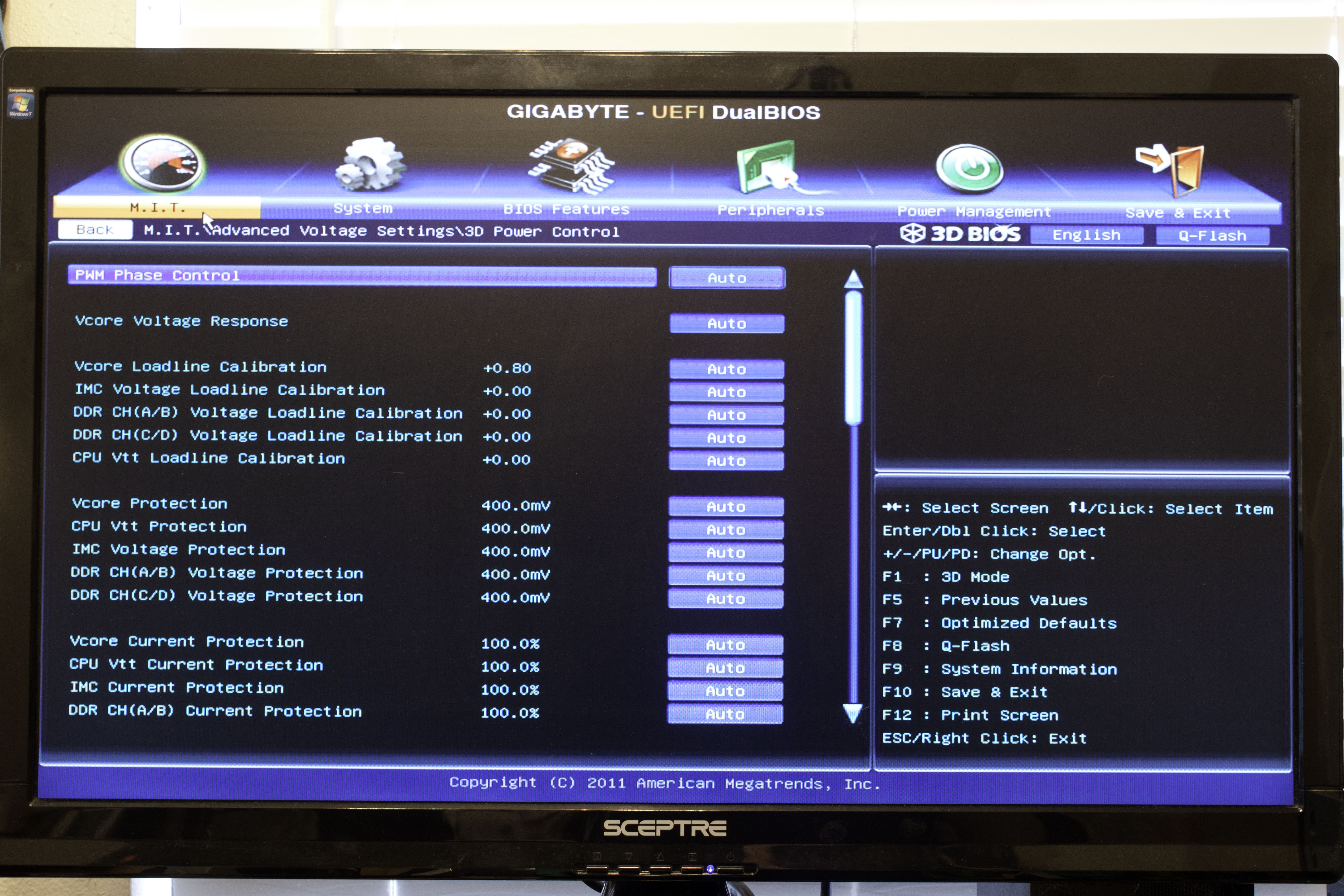BIOS -
BIOS is an acronym that stands for Basic Input/Output System. It is meant to control your product at a very low level. As of right now there are three regularly used BIOS formats (there are actually more than that but there are three common ones). These are the AMI (American Megatrends Incorporated), Award, and Phoenix. On the G1.Assassin2 Gigabyte has created a new version of the UEFI (Unified Extensible Firmware Interface) BIOS. They are calling this their 3D BIOS. Now when you enter the BIOS you have two ways to tweak and tinker. You can directly click on the items that you want to adjust (in the image below we have 3DPower Selected). Or you can click on any of the icons at the bottom and get around the normal way.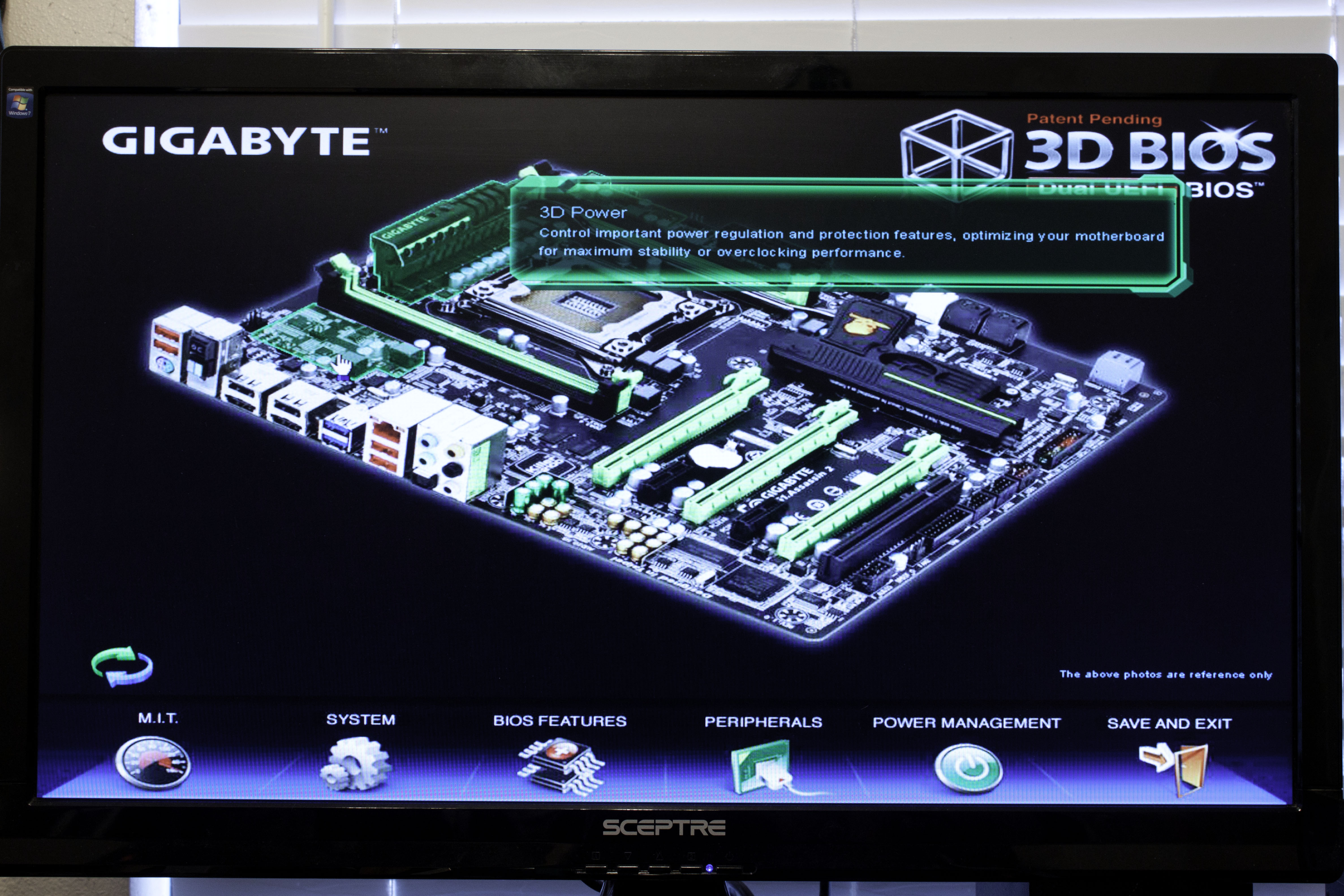
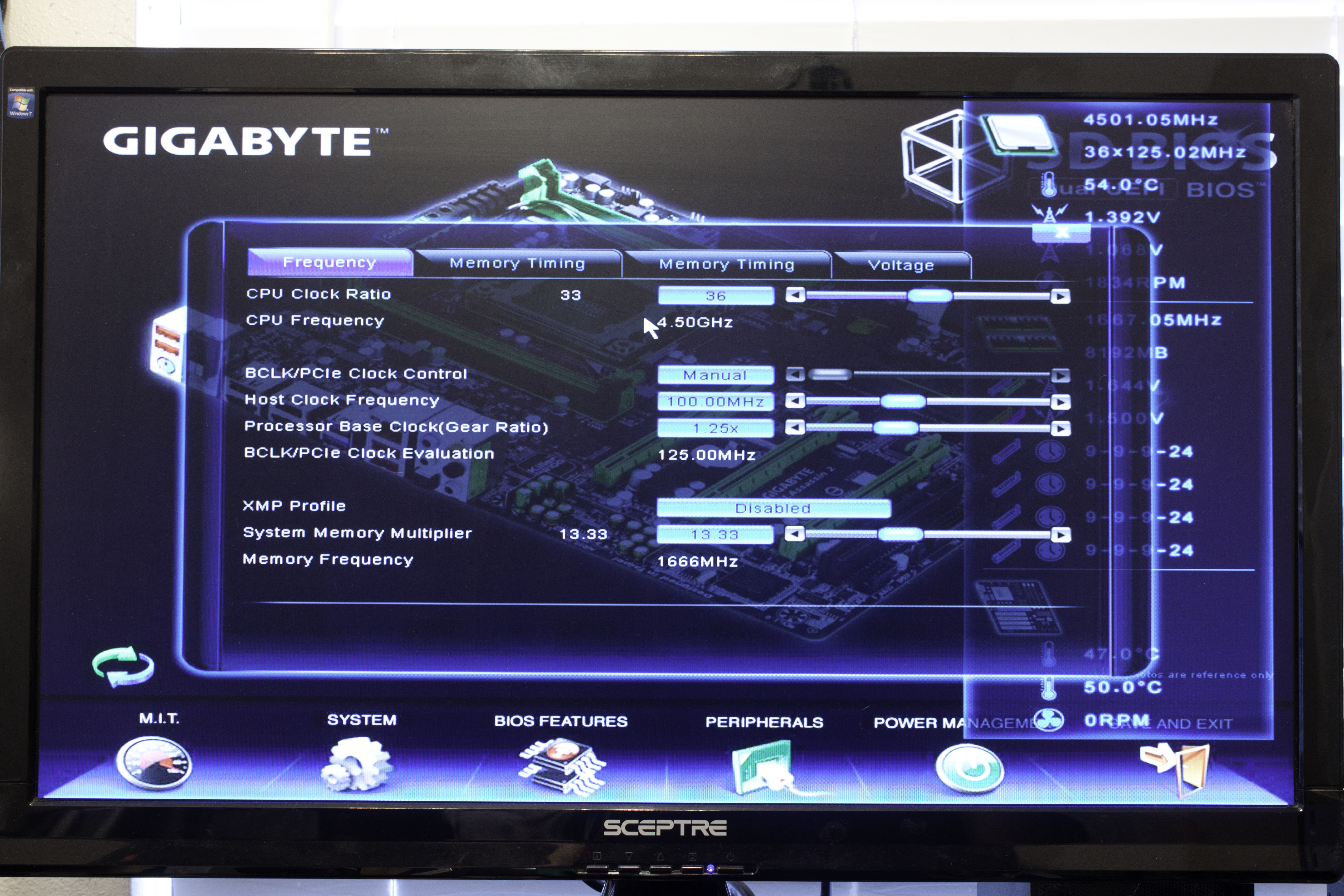 |
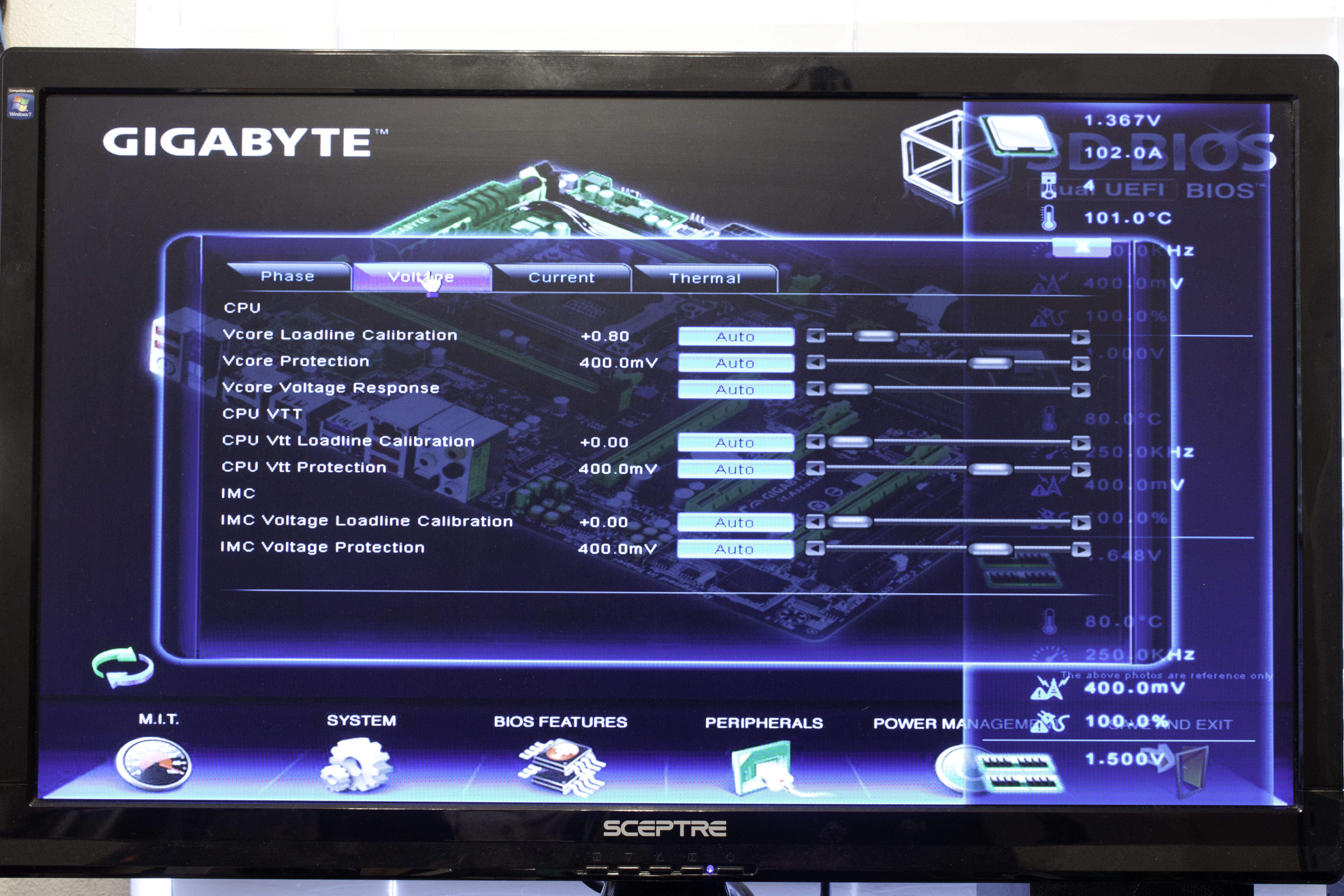 |
When you click on an object on the picture of the motherboard an overlay pops up that gives you the control option. A side-bar also opens up that is supposed to list current settings. The problem is that the main overlay covers much of the information and both disappear when you close the main overlay. I am sure that Gigabyte will fix this in future upgrades, but for now it is slightly annoying. Once you get used to using it the 3DBIOS can be quite easy to get around in. It does still have the same issue that all UEFI BIOSes have though, because this is a UI over the actual BIOS and the graphics are very basic your mouse movements are often very sluggish. This is not a Gigabyte issue, but is a general issue with UEFI in general and is one that we imagine will be fixed as the technology improves.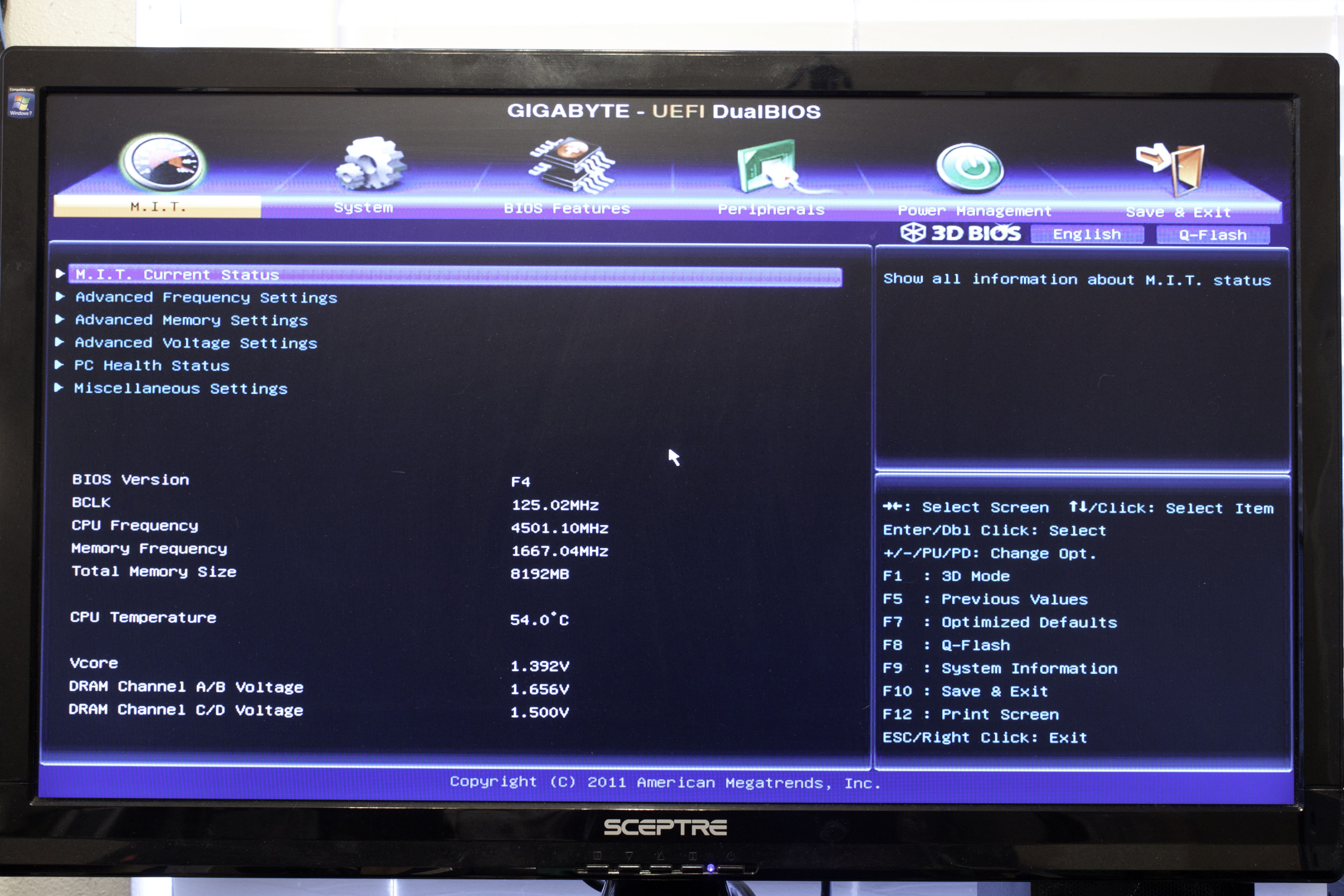
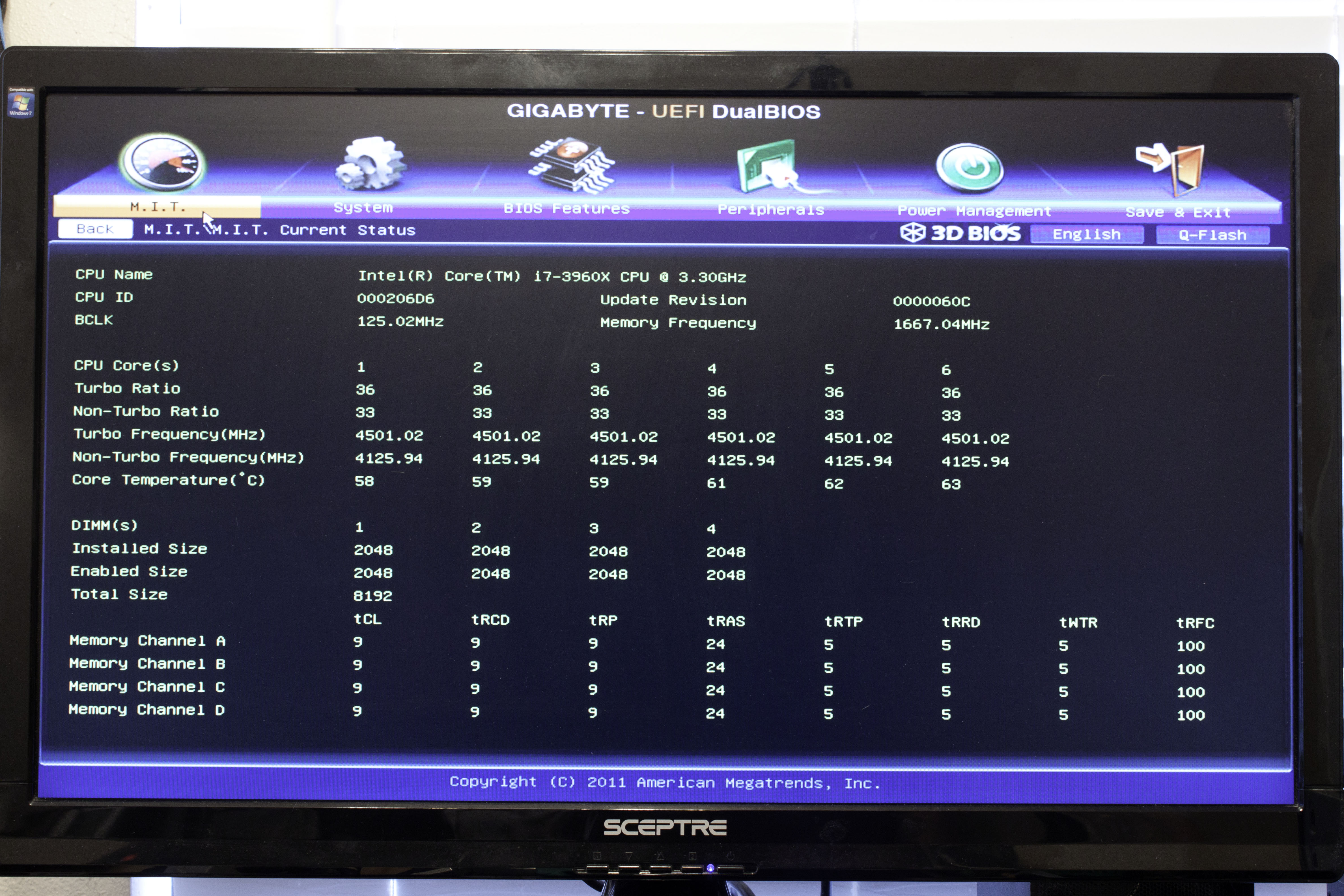 |
 |
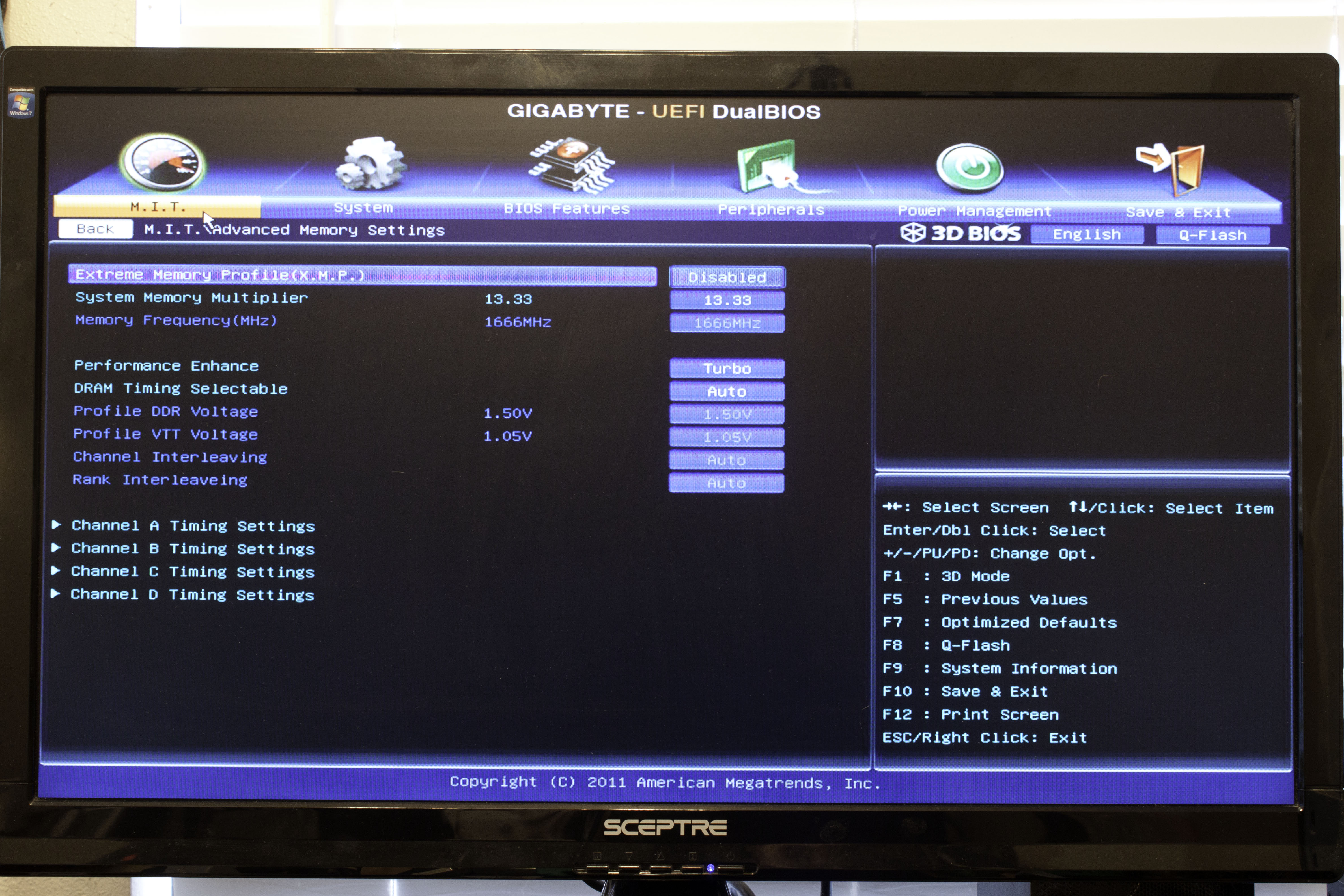 |
If you are not a fan of the 3D BIOS you can still get around using the regular UEFI BIOS. Here the controls and feel are very similar to what we got used to with the Z68 and P67. It also follows the same basic layout of other Gigabyte BIOSes. You still have the Motherboard Intelligent Tweaker and all of the pages that you would expect to find there.
There are some new entries here as well; the 3D Power section has controls to tweak the way the power regulation runs on the board. There are options for changing the phase of the PWM as well as making minute adjustments to protect the power regulation from damage due to drawing too much current through the system. These settings can be dangerous if you do not know what you are doing and push too much through the system.
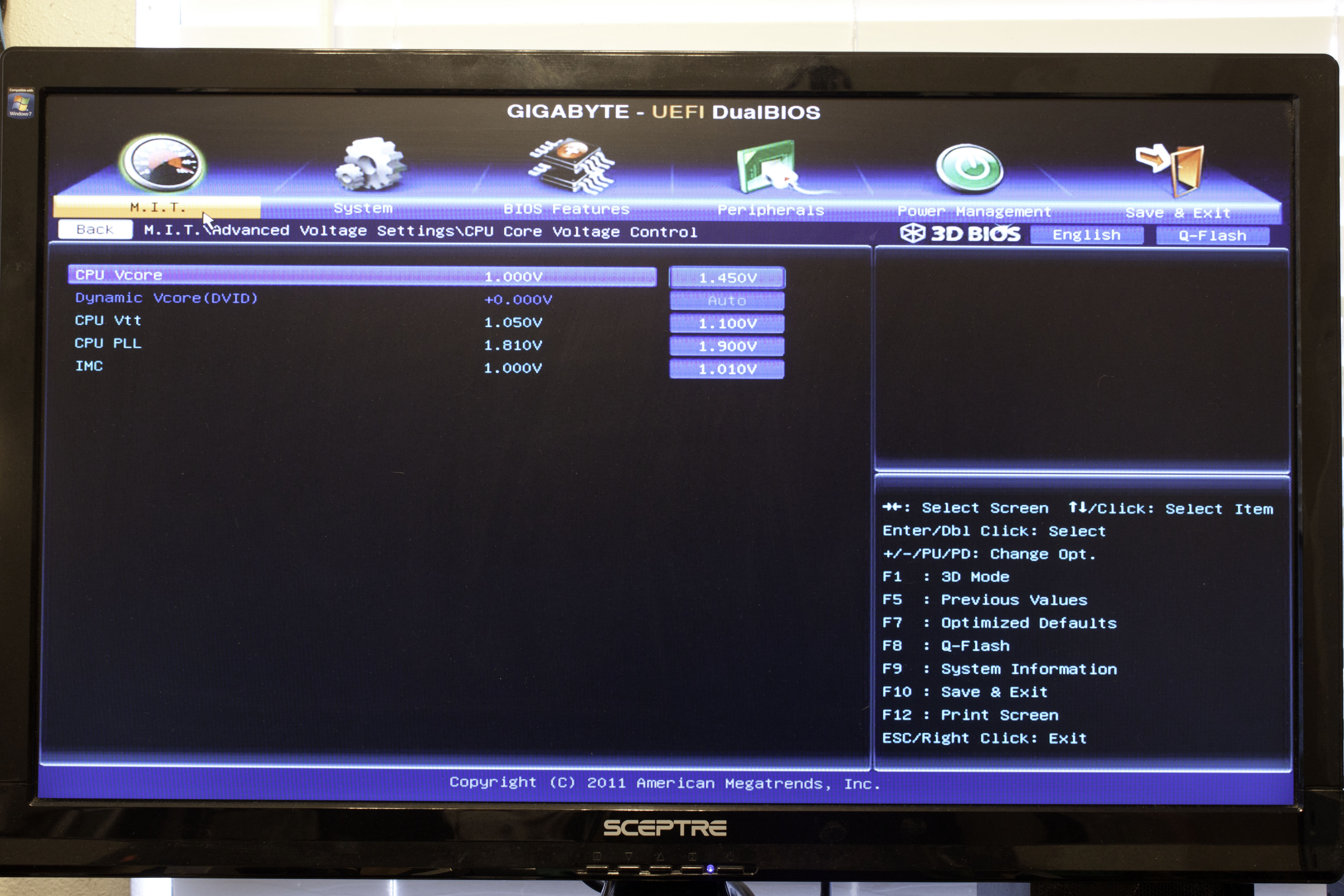 |
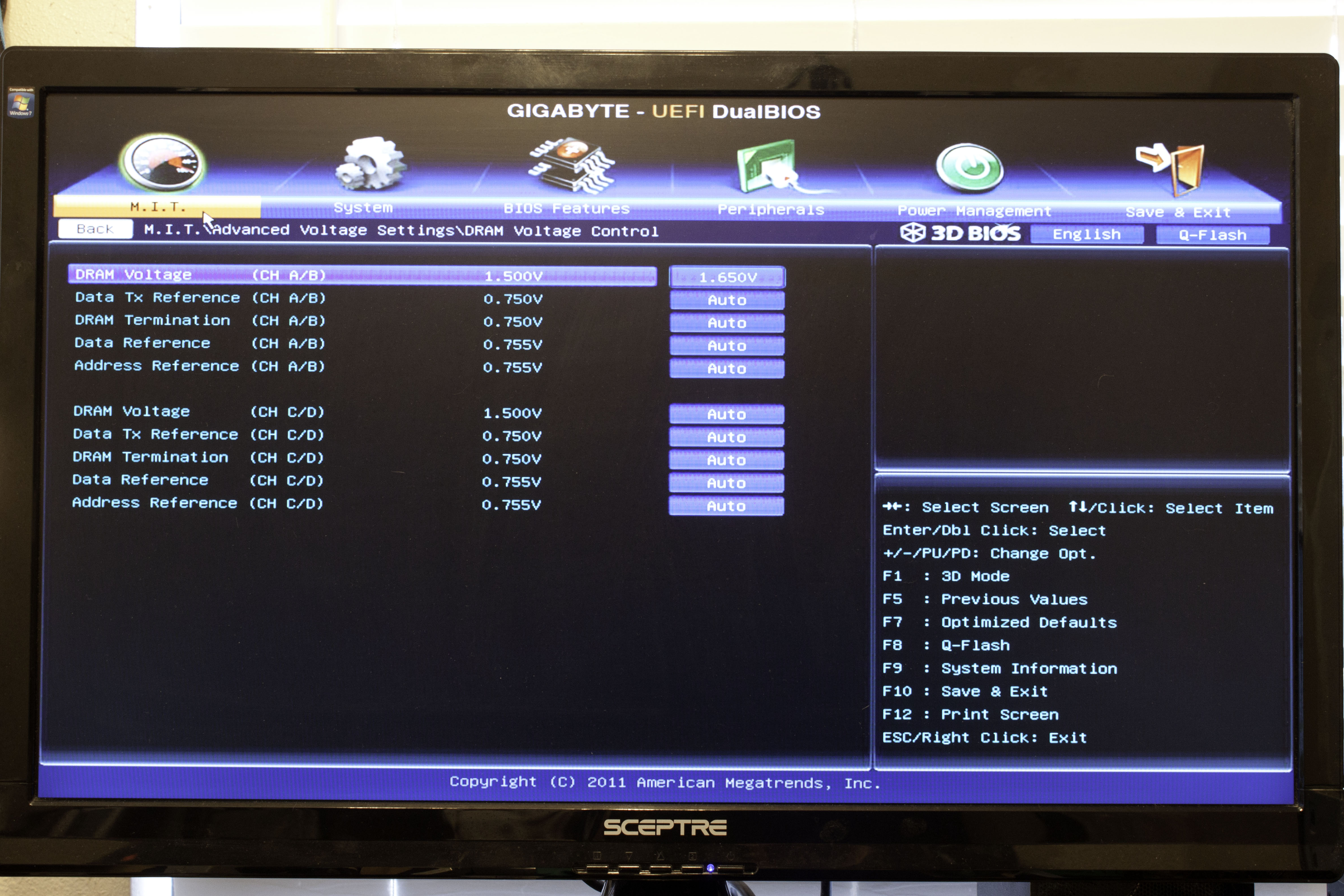 |
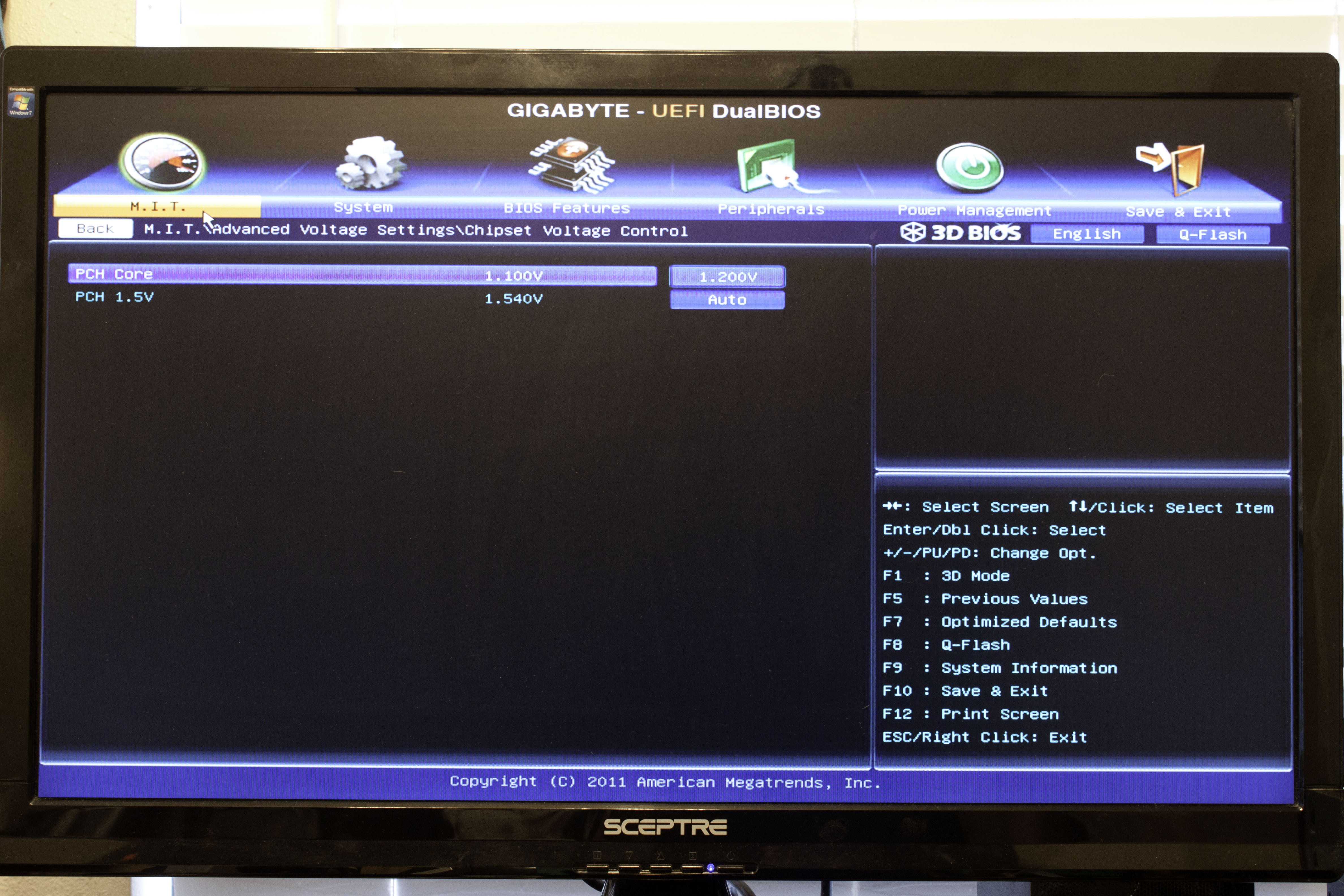 |
The rest of the voltage controls are what you have come to expect from a Gigabyte overclocking board (come to think on that from almost any Gigabyte Board).
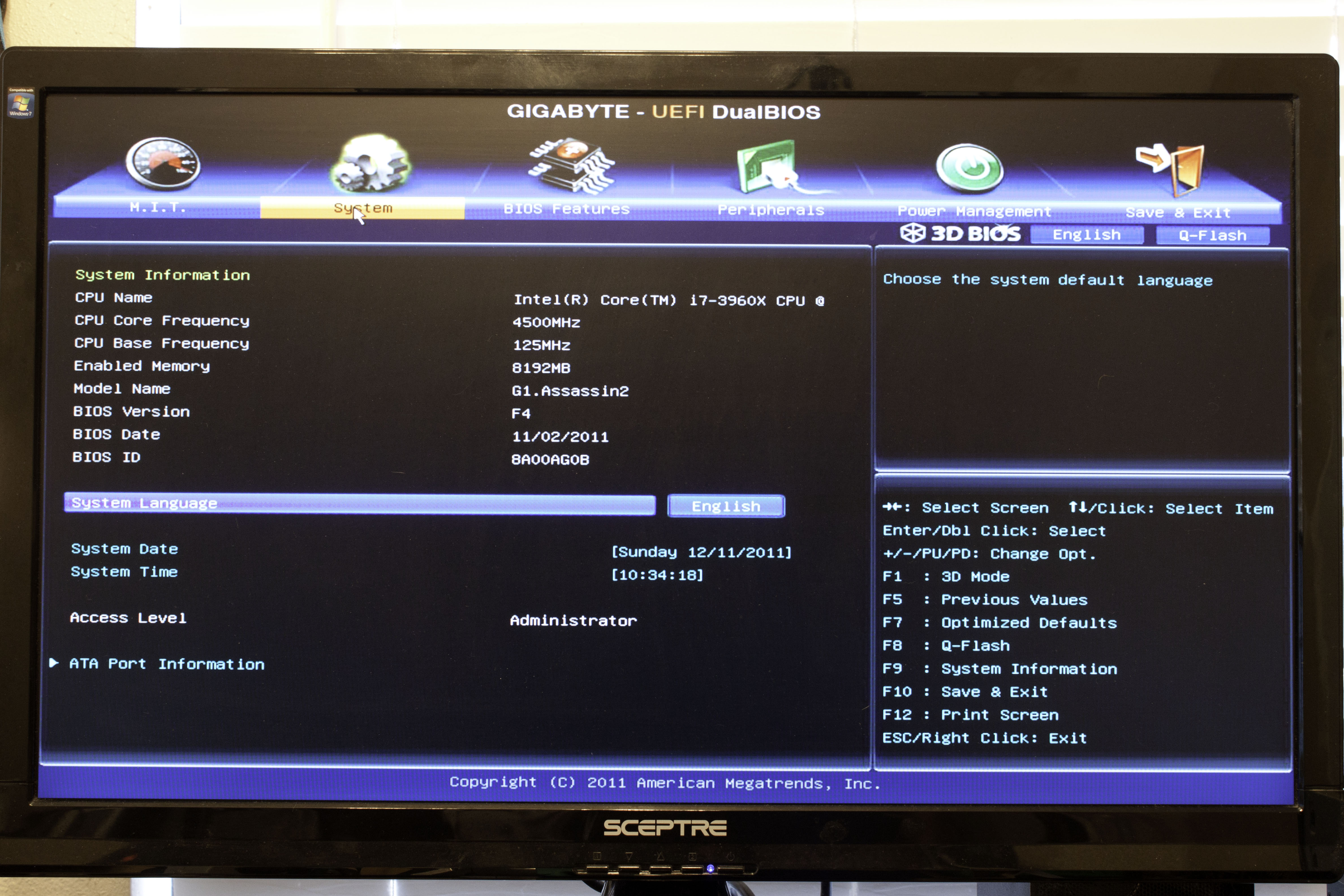 |
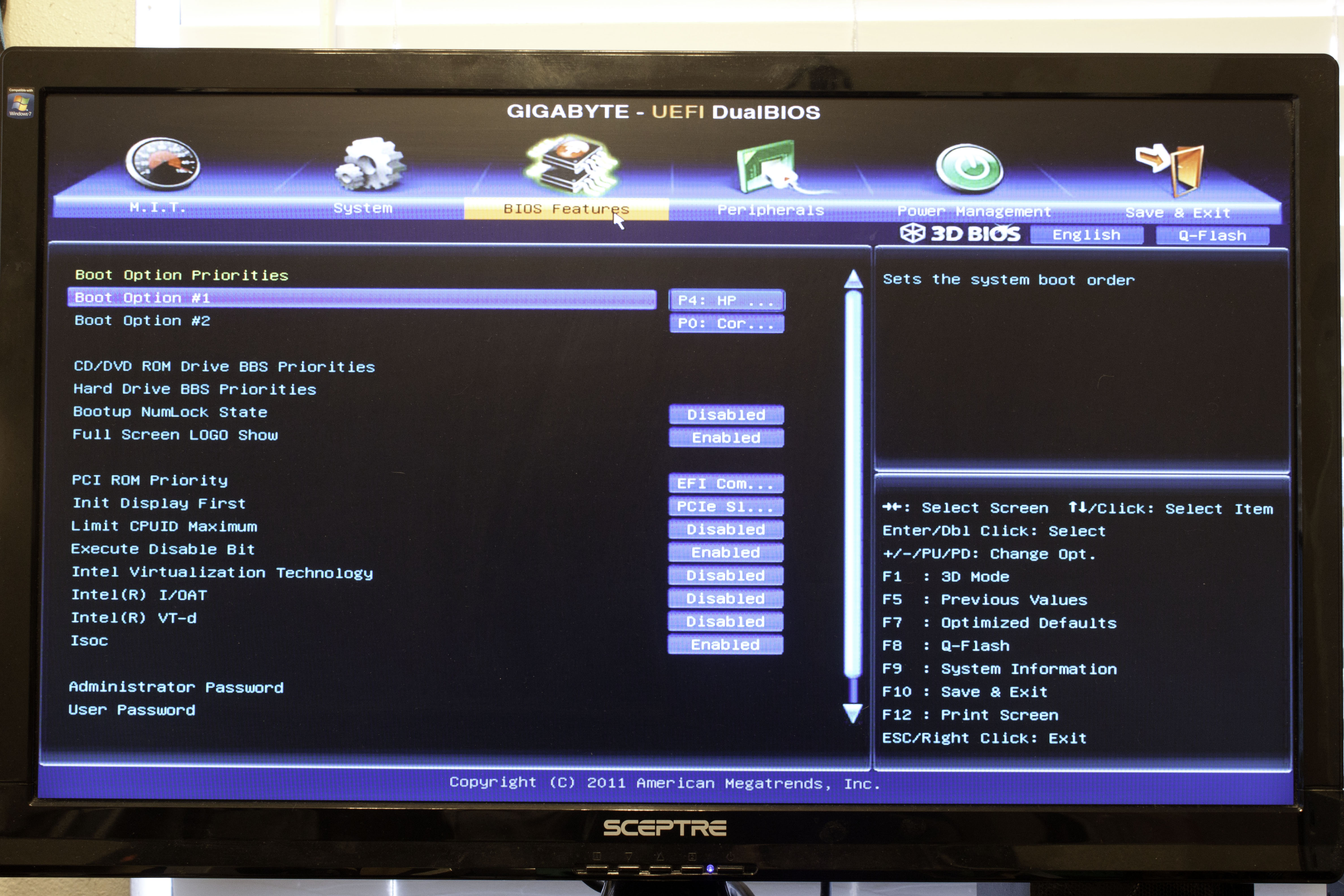 |
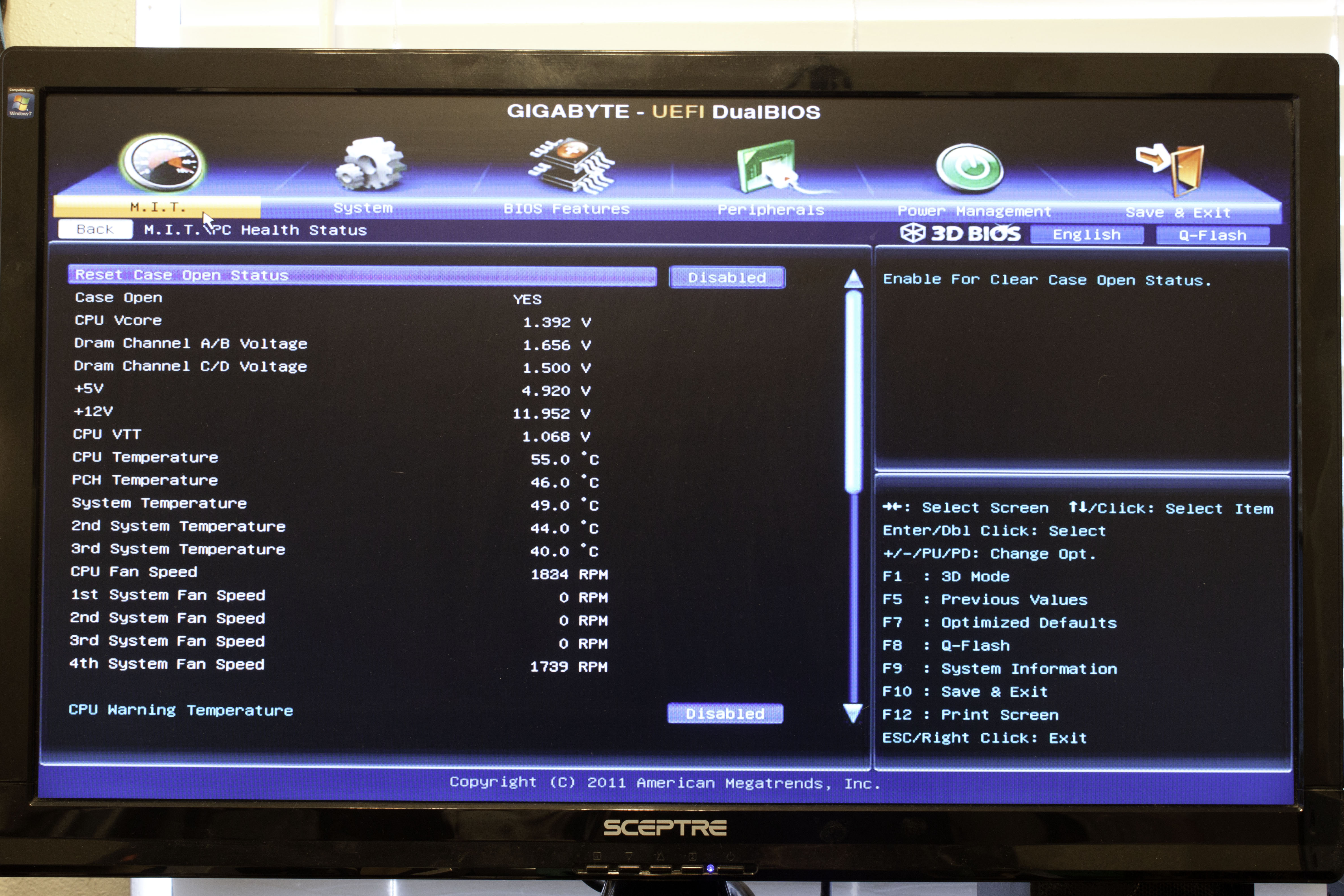 |
The rest of the BIOS is pretty much the same a s regular BIOS with the exception of being able to use the mouse to move around.
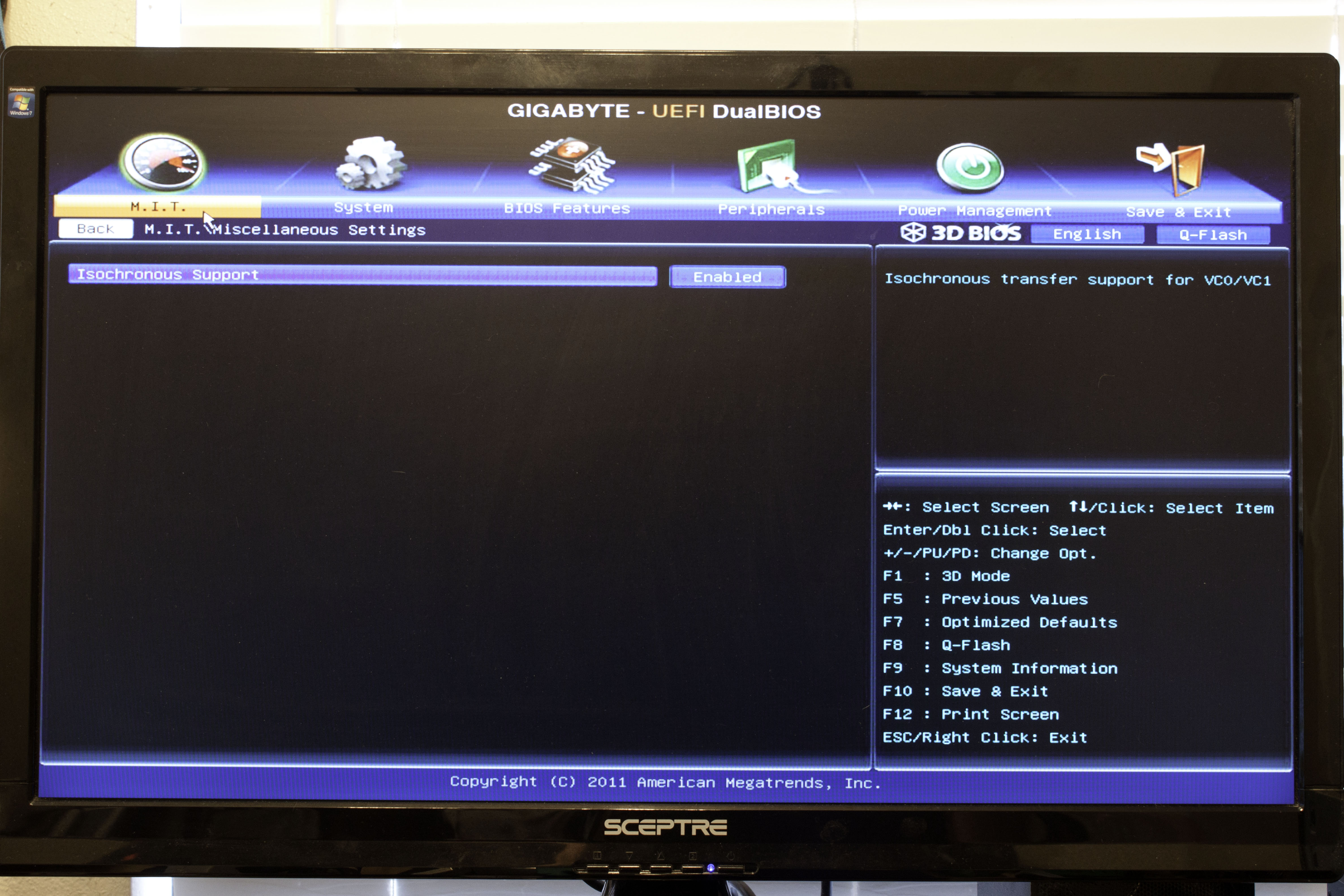 |
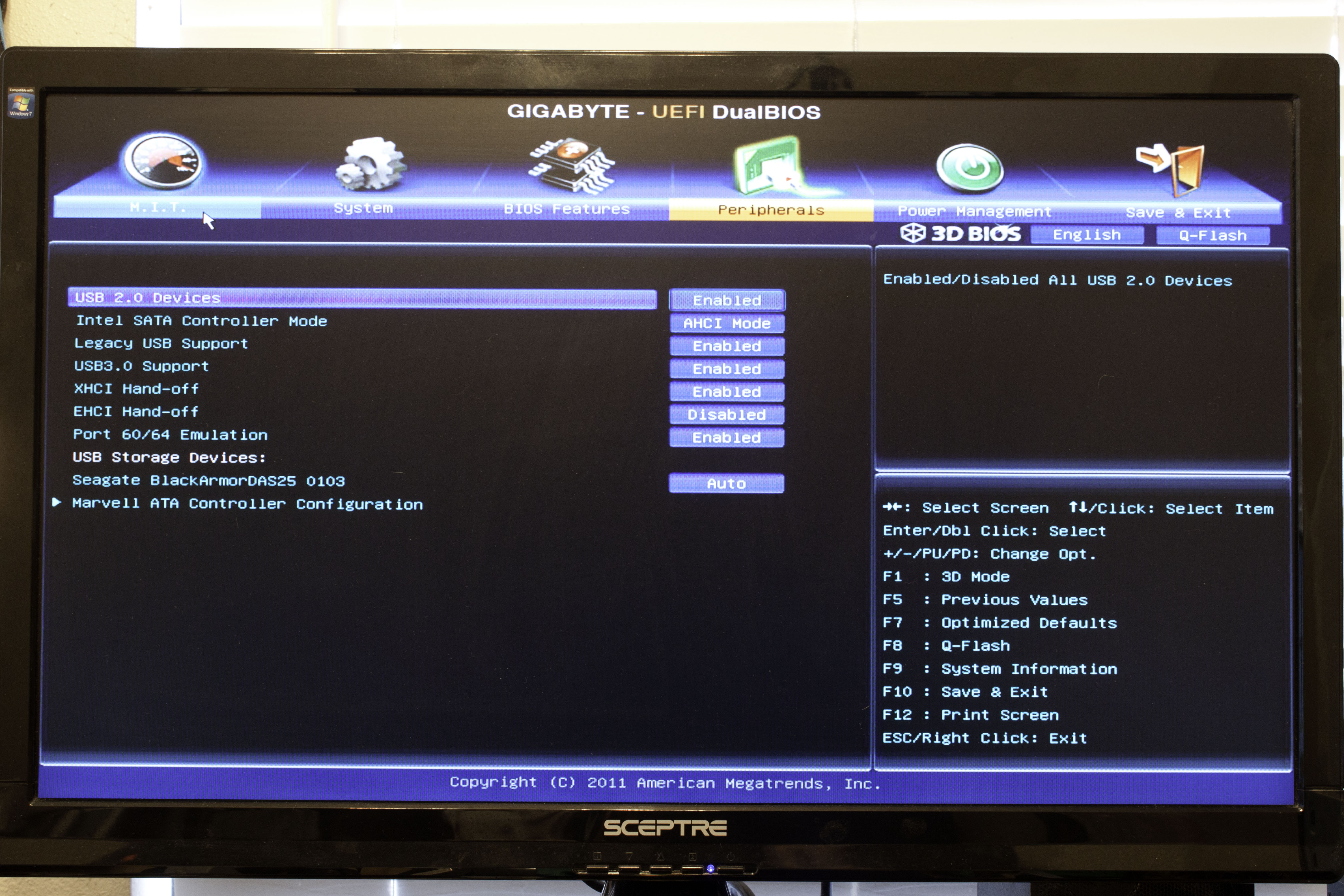 |
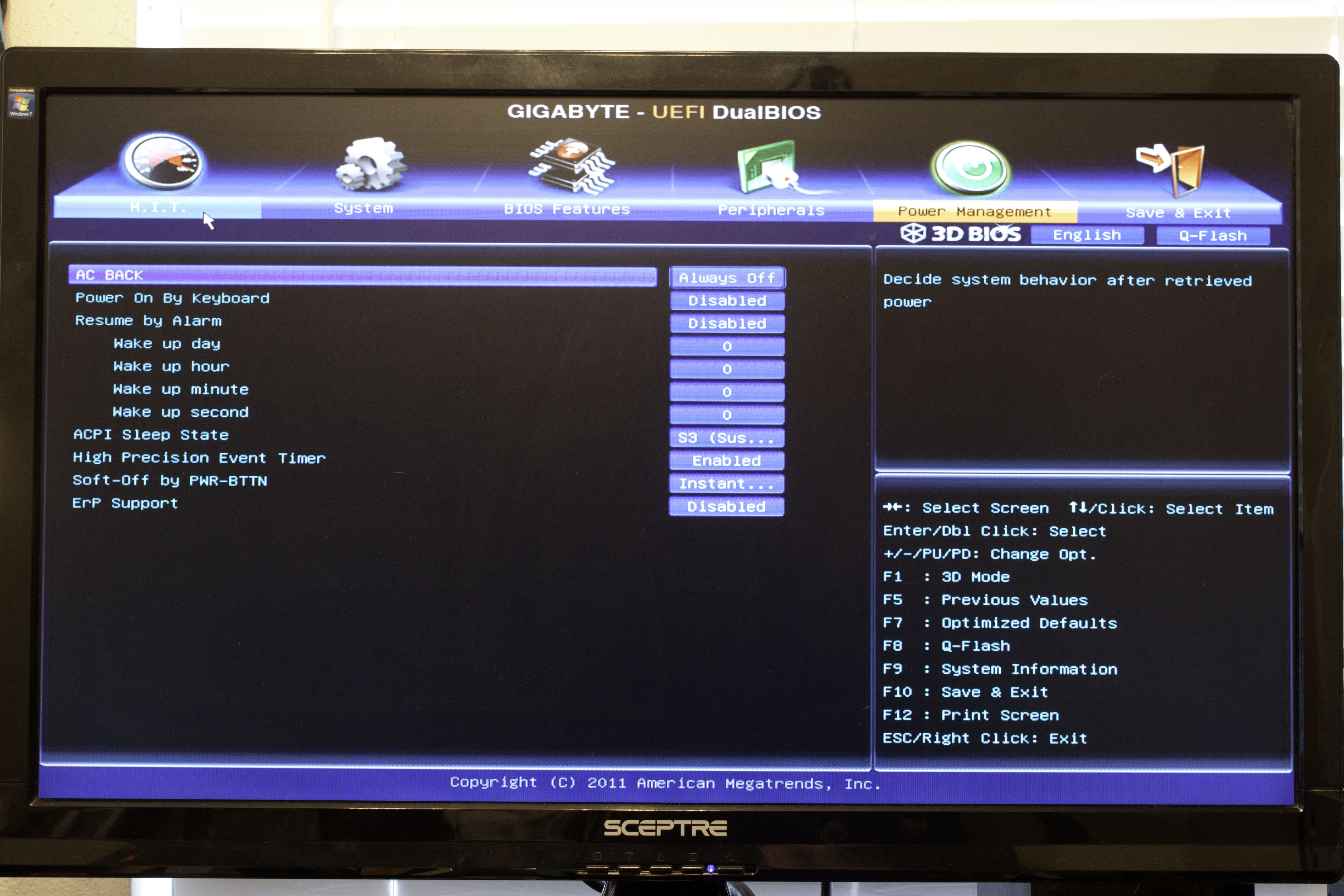 |
Overclocking -
Overclocking the G1.AssassinG2 was very simple, but I did run into a couple of things that were annoying. The first was an issue with the actual BIOS. When I exceeded the threshold of what the board was capable of (at the voltage I was using) the board would not post. I have gotten so used to boards just running in a “safe mode” when this happens that I was rather surprised when I had to reset the BIOS to get things running again. Our final OC was 36 x 125 (using the 1.25 BCLK Gear Ratio). This gave us an overclock of 4.5GHz. Our final memory clock was 1666MHz. When I tried to bump the BCLK up by even one more MHz the system failed completely (which meant I had to clear the BIOS and start over). 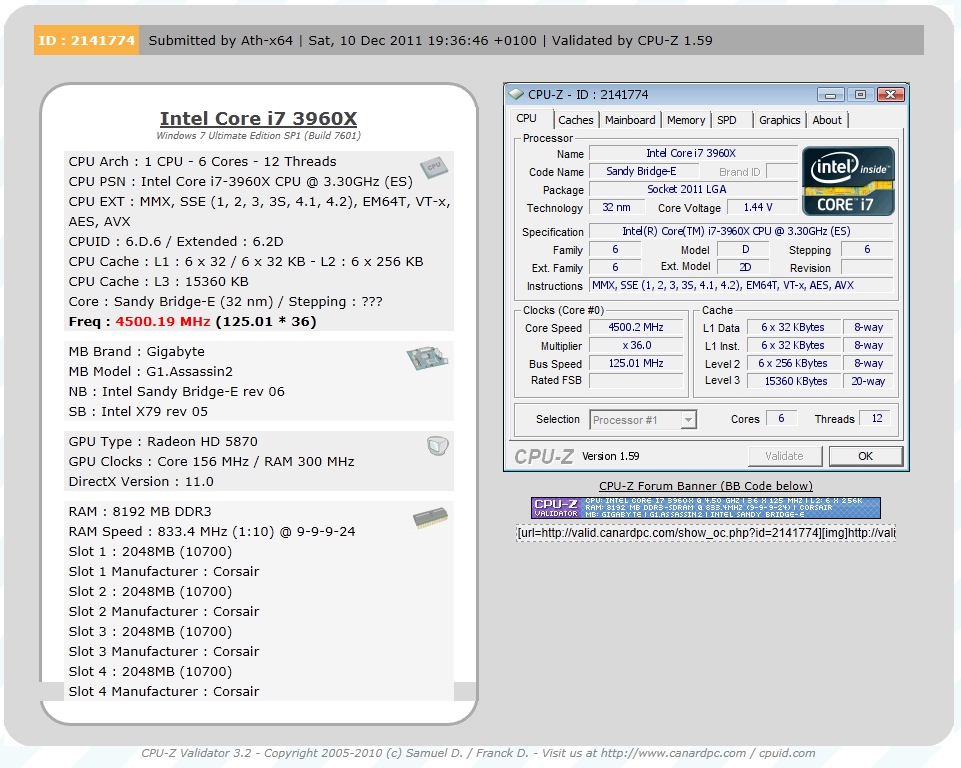
Of course overclocking is a picky subject. I can buy to identical CPUs from the store and they will not always perform the same way under stress. This is the same with motherboards, RAM and GPUs. So again it is important to keep in mind that our results represent a specific hardware configuration. Yours may be similar but will rarely be identical.
Overclocking Tools -
The G1.Assassin2 also comes with Gigabyte’s EasyTeun6. We have covered this tool on more than one occasion so we will not go into too much detail, but we will say that the utility is functional if somewhat cluttered and non-intuitive. The first two pages are pretty much the same information you would see from a CPUz readout for your processor and memory.
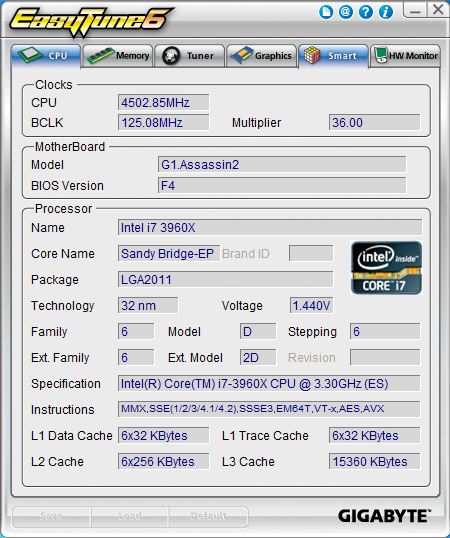 |
 |
The third deals with overclocking. You have three levels of control here;
QuickBoost which gives you three click-and-go options for overclocking
Easy which only lets you adjust the BCLK
Advanced which gives you a very large number of options for overclocking from inside Windows.
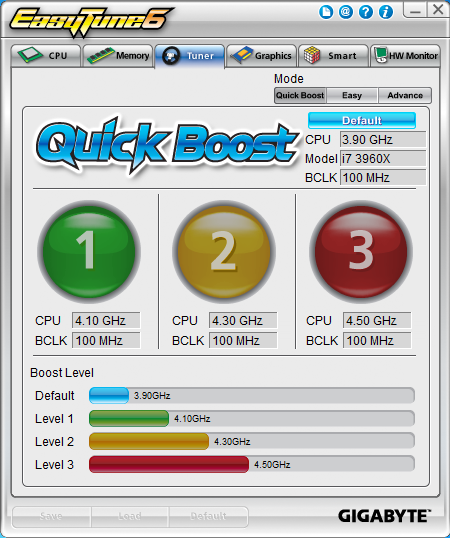 |
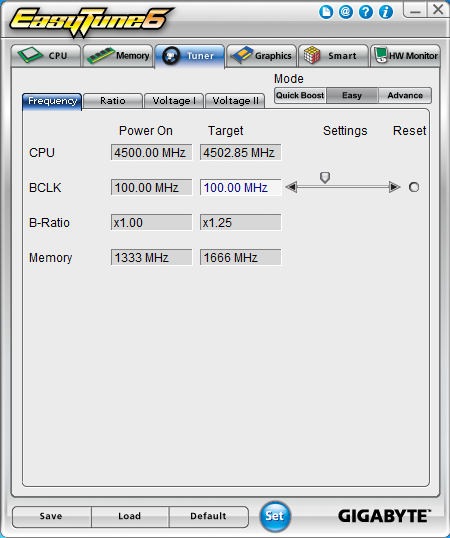 |
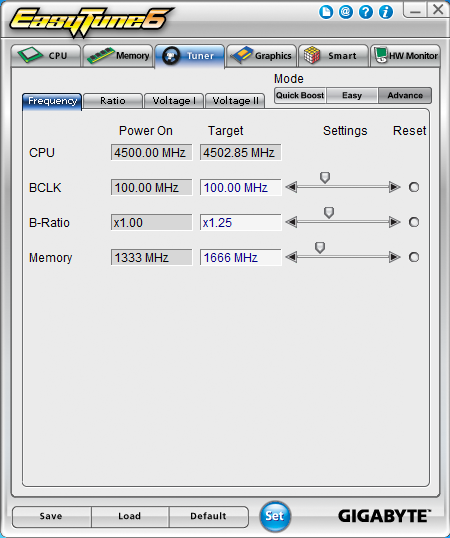 |
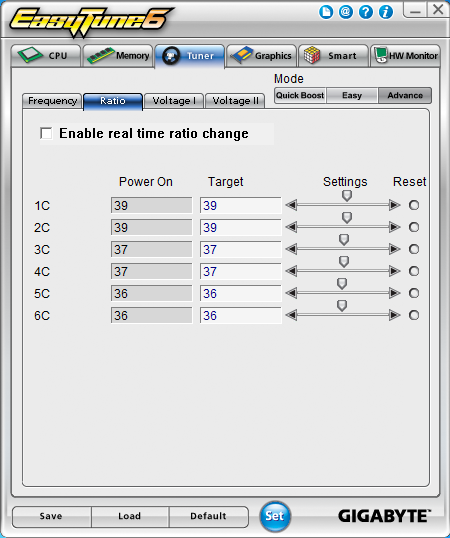 |
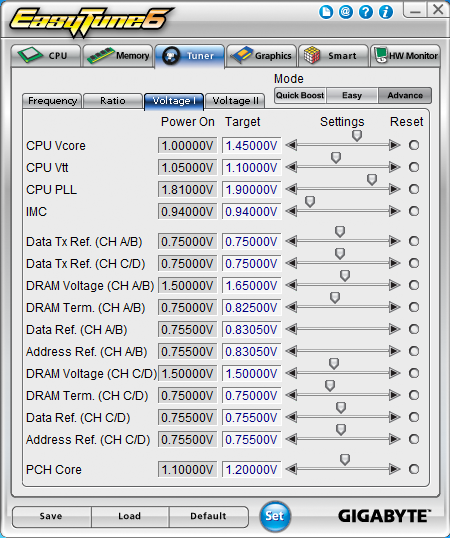 |
 |
Tab number fours lets you overclock some GPUs, but only up to the limits of their default voltage. There are no options for voltage tweaking, even if the card supports it.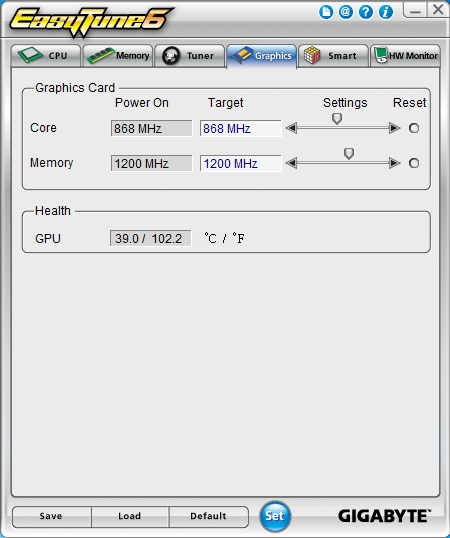
The last two pages deal with monitoring and cooling. Page five has options to adjust the SmartFan profiles while page six is your hardware monitor.
 |
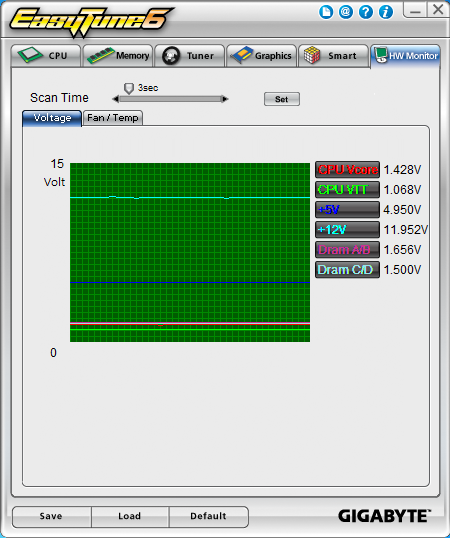 |
Like we said, functional but not the cleanest utility out there.
The Test System and Comments -
Our test system is built on an open bench. This has two effects on testing. First it allows us to see everything and also to setup and disassemble the test rigs quickly. Second it means that we cannot gauge the potential air flow found in a normal case. The air is pretty stagnant; some may say this is a great neutral testing method and it can be. However, it does mean that the temperature reading taken off of the components are not accurate to what an average consumer would see. This means that your thermal performance will vary from what we see here. 
The G1.Assassin2 was (as you might expect) very simple to get setup. All we did was mount everything on the board, install Windows, install the drivers and utilities using the option on the DVD to do this and then run about four hours-worth of updates for Windows… but really there was not much more to it than that. One nice thing about the G1.Assassin2 over the original assassin is that it is normal ATX sized. You do not have to worry about having a massive case to use this one with and you still have options for Tri-SLI. In terms of general usage we found the G1.Assassin2 to be quick and easy to work with. We did not find anything that stood out as a possible issue, everything just seemed to work.
Performance testing overview -
Our testing is a little different than most. We combine both synthetic and real-world applications to simulate the types of performance common to the individual products. For motherboards this means that we run roughly six synthetic tests and two real-world. We will be expanding the real-world testing in the near future. But there is more to performance than just the raw numbers. As there are multiple components and sub-components on a motherboard there each item can have a distinct impact on the way the product will perform once you get it in your system. It is important to note not only the actual results but what they mean to you as a potential consumer. We will try to give this information to you. But we do not just cover the performance aspects that are measurable. We also talk about the components that might not have a direct benchmark. These are items like Audio Quality, ease of use and installation.
Section 1 Subsystems
Memory -
Memory performance is very important on a motherboard, especially when you have a CPU with multiple cores and threads. If you have slow memory your cores and threads can become starved for data to execute. To test memory performance we run both Sisoft’s SANDRA and AIDA64. These two combine to not only give us accurate numbers but to validate each other. For testing at stock speeds the memory is hard set to 1333MHz while overclocking testing is done at the highest stable speed for the voltage of 1.65v this is due to the different memory dividers for each CPU. As such, the memory speeds will vary greatly. This means that the overclocked numbers are a little misleading and while they can show a trend are really only included to show if a board has a problem with memory performance at high clockspeeds.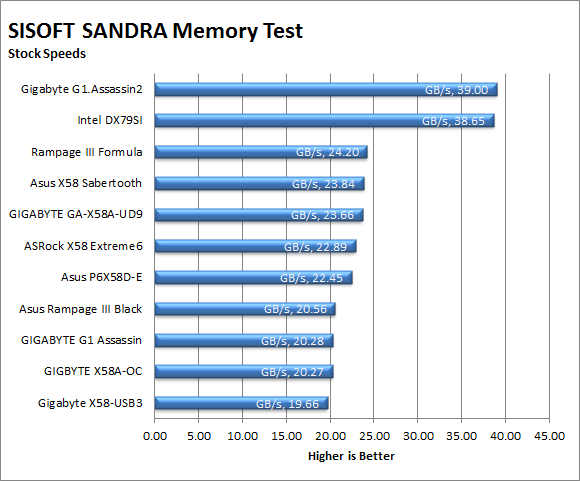
The G1.Asssassin2 is even faster than the X79SI we used for our initial review of the Sandy Bridge E this has to be due to the removal of the other four RAM slots. Ok, so the performance difference is not much on paper, but we imagine that we will see this come back in many of our memory intensive tests like HyperPi, Cinebench and possibly even LightWave 3D. For the consumer this will help out with multi-tasking as well as gaming and other workloads that use up your system memory. 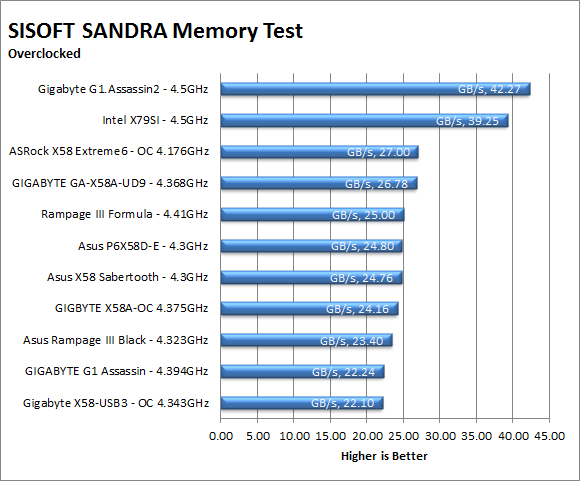
| AIDA64 Stock Memory Performance | AIDA64 Overclocked Memory Performance |
 |
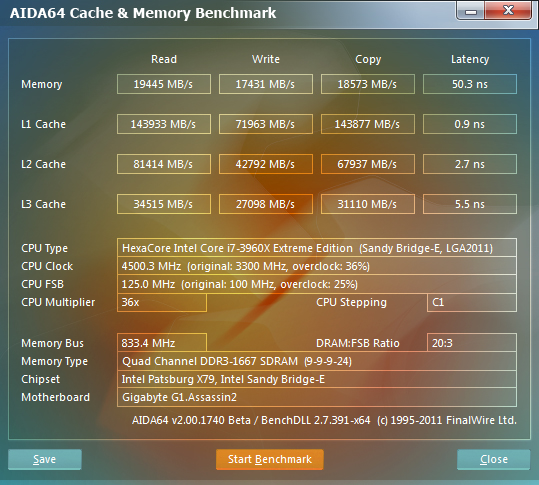 |
Drive performance -
Drive performance is also one of the major subsystems that goes to make up the performance of a motherboard. For our testing we use Sandra and AIDA64 again. We only test with single drives for each type of controller present on the motherboard (unless it is a professional product where we will use RIAD 5 and/or 10). We have also begun using a Seagate PS-110 USB 3 external HDD for our USB 3.0 performance. As a side note, we include the overclocked numbers here to make sure (again) that you are not going to see a major drop in performance due to minor instabilities at high clock speeds.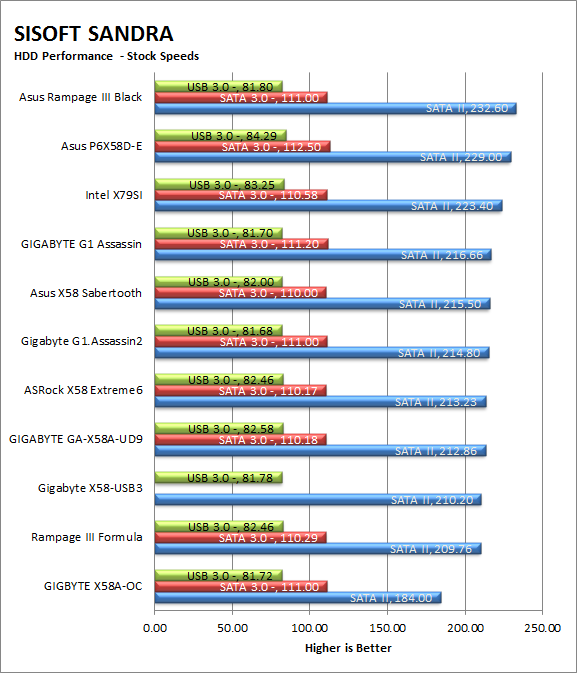
Drive performance is not a strong suit of the G1.Assassin2. It is about average for the boards we have tested and a little slower than the X79SI. The drive speed difference is larger than the memory performance gap which could allow the X79SI to keep ahead of the G1.Assassin2.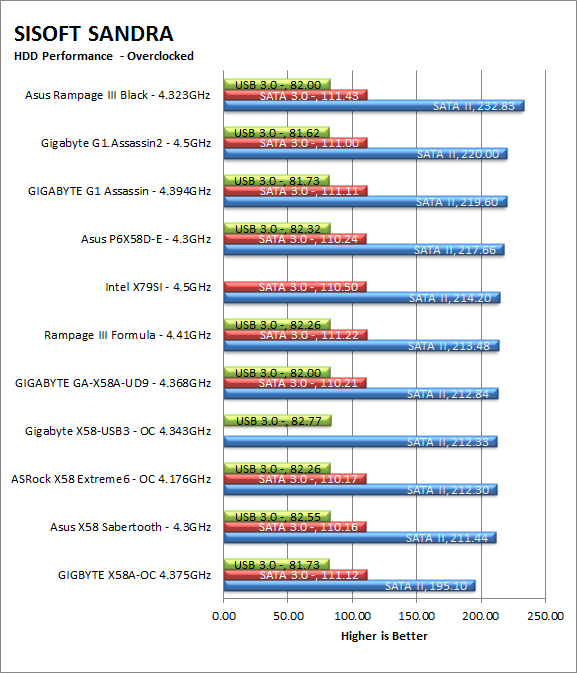
| AIDA64 Stock HDD Performance | AIDA64 Overclocked HDD Performance |
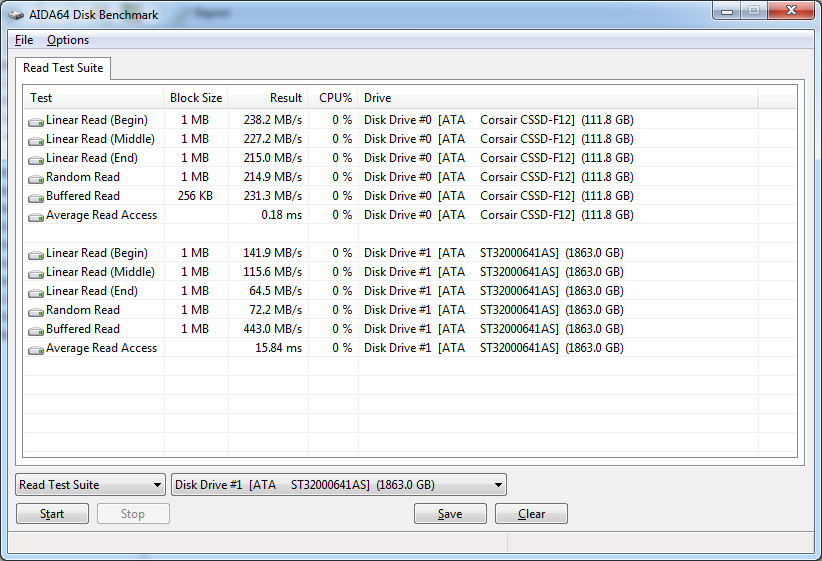 |
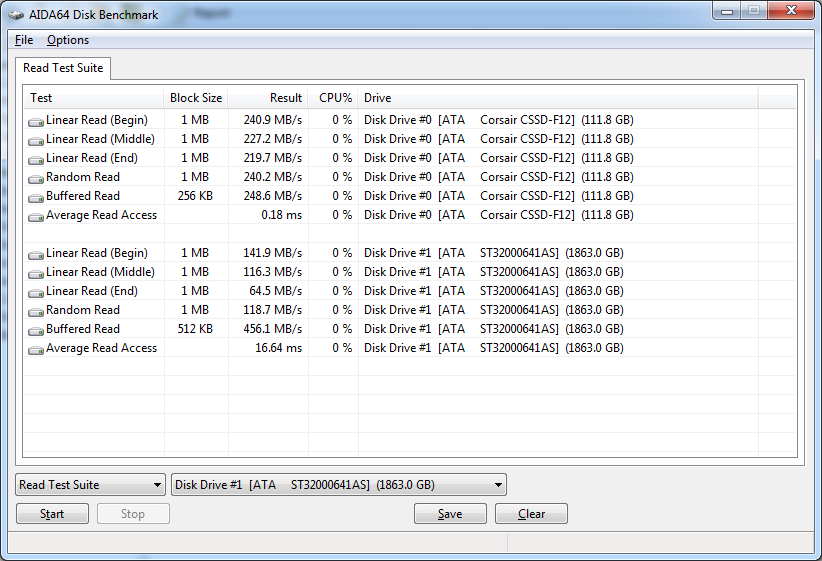 |
| AIDA64 Stock USB 3.0 Performance | AIDA64 Overclocked USB 3.0 Performance |
 |
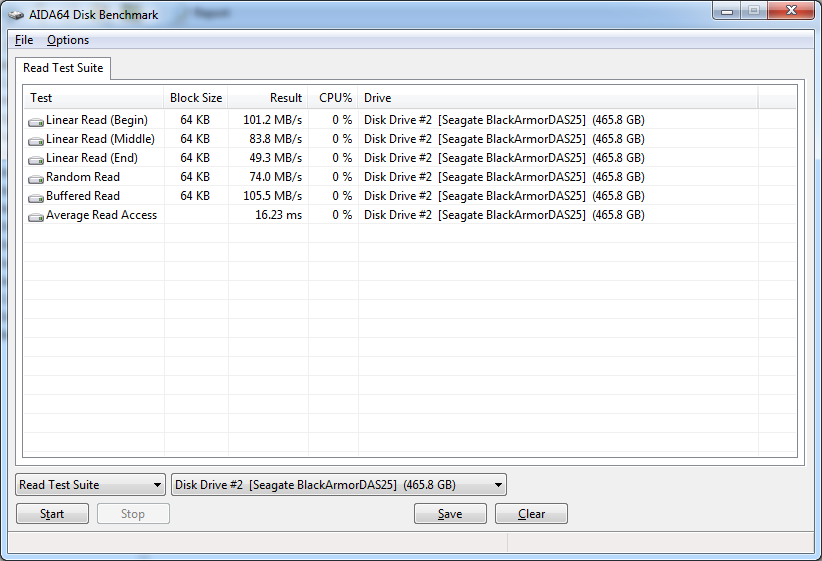 |
Power -
Power efficiency is another of those misnomers that we get caught up in. We hear about idle states and power gates. But what does that mean to you and I? On the surface having power management that reduces idle power sounds great and can be a benefit to someone that leaves their system on for long periods of time (and inactive) but how a system handles power under load and the delta between the two states is often more important than the idle power usage numbers. We use only P3 Kill A Watt instruments for measuring power. 
The G1.Assassin2, like its older brother, can pull some power from the wall. It is not the hungriest board we have tested and is more power efficient that the original G1.Assassin, but we hoped for more. The draw that you are seeing is due to both the KillerNIC and the Full X-fi audio card that are on the board. 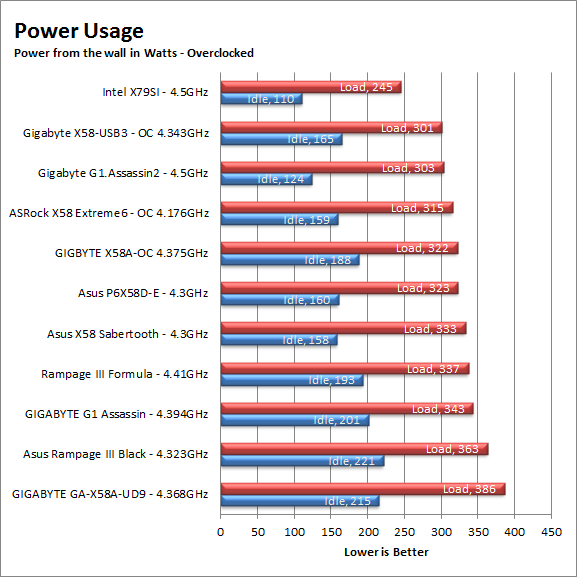
Cooling (Board Level)
Board level cooling is an important factor in product performance and longevity. Components like the chipset, VRM modules and even capacitors need to be kept relatively cool to prevent failure. As these parts are made of silicon, they have a thermal breakdown threshold; or melting point. At that temperature the actual transistors built into chip will begin to deform and break down. Granted, the threshold is often very high, but you still need to make sure that components stay away from this level of heat for longer product life. 
When we first looked at the G1.Assassin2 we worried about the cooling on the X79 chipset, after all the heatsink there is not much more than a big block of metal. However, we soon found out that the cooler is pretty efficient. The G1.Assassin2 is the coolest running board out of the ones we tested. At least it was at stock speeds. When we overclocked the board it was a different story, but then again it always is when you overclock.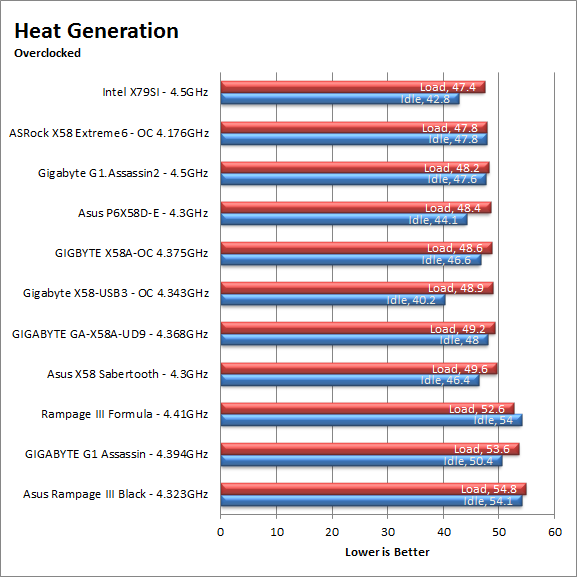
Audio -
Audio is highly subjective. What we find pleasing may sound “off” to you. That is always going to the problem with testing audio; results will vary too widely depending on the tastes of the listener. However, there are ways of measuring the audio output with an objective ear. There is also the issue of audio causing performance issues in gaming and video playback. The reason this is a potential source of concern is that all onboard audio CODECs (Compression/Decompression) are CPU controlled. This means that while the audio chip controls the audio levels and effects of the audio the actual work is done on the CPU. Usually this will not be a problem with today’s powerful CPUs. Even the lower and consumer level products can handle high-end audio these days. But again there is the chance that a bad design or software will hinder your system and performance. On the other side the limits of board space, cost, etc will also prevent the level of audio quality you can get from an add-in board. We test all audio parts with three media types, Movie (DVD), MP3 Music, and Gaming. These are pushed to our Tec On model 55 Tube Amp to see if we can detect any signal issues in the reproduction.
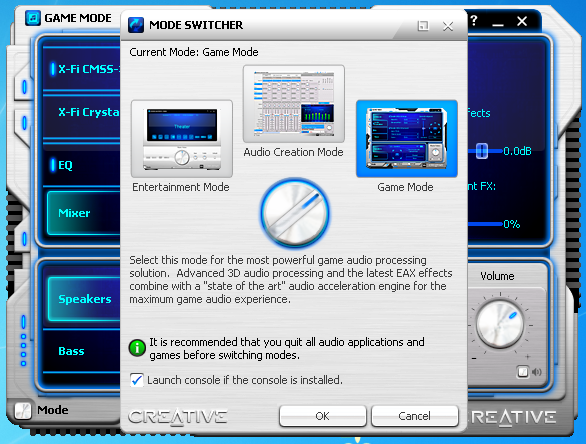 |
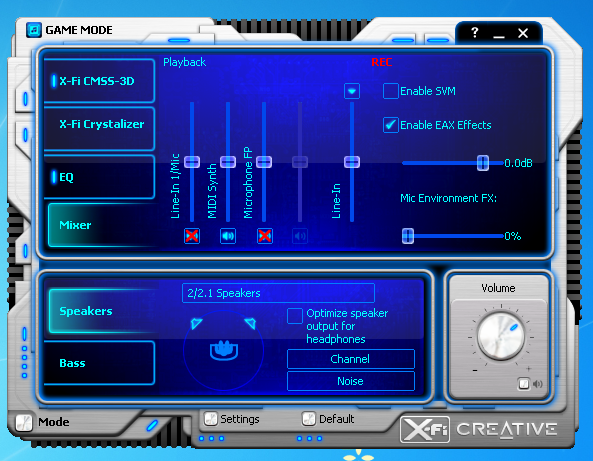 |
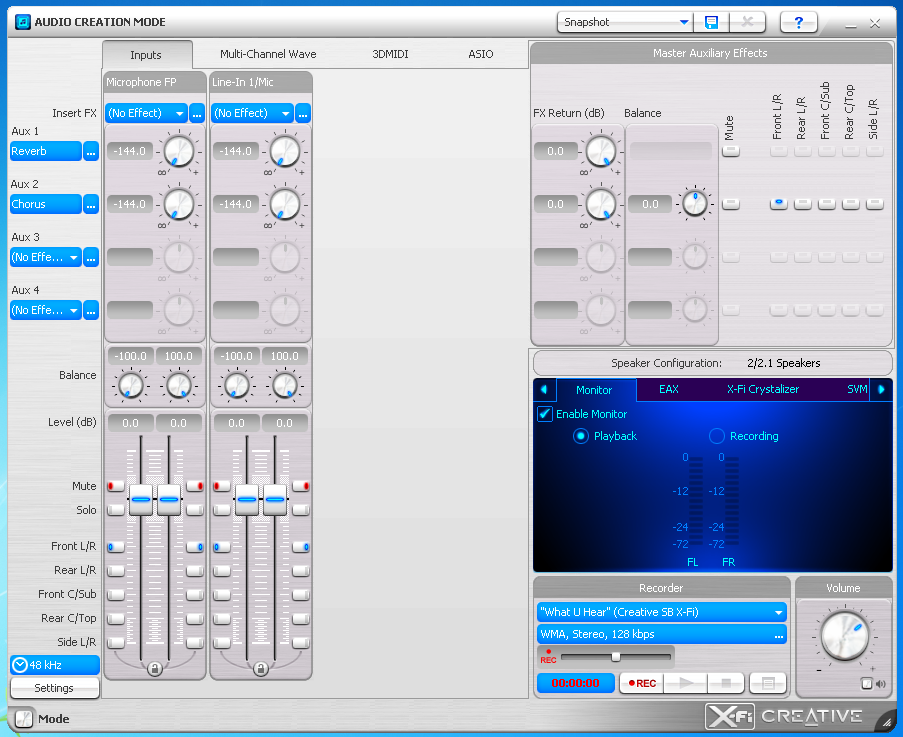 |
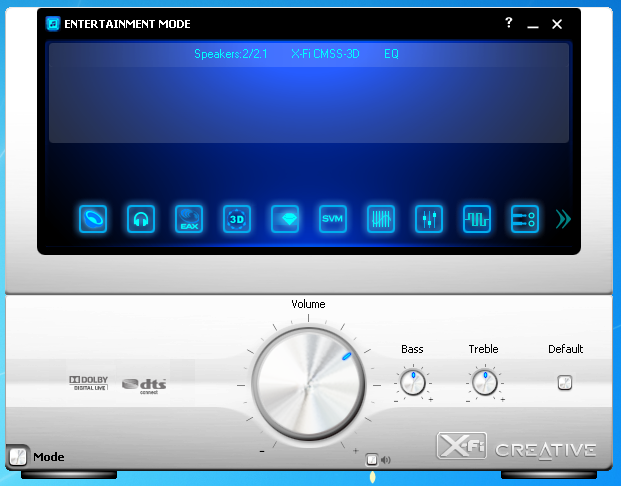 |
As the audio on the G1.Assassin2 is a full Creative Labs X-fi, you can pretty much guess that the audio is good. We did not run into any issues playing back any of the audio we threw at it and even gaming was excellent. The controls for the onboard X-fi are also great with three main modes available; Game Mode, Entertainment Mode, and Audio Creation.
Networking -
This one is something that is a requirement anymore. If you have a computer, the chances are good (like 99%) that you are also connected to high-speed internet. With this you need a good and solid LAN chip to make sure that your data flows properly out and back.
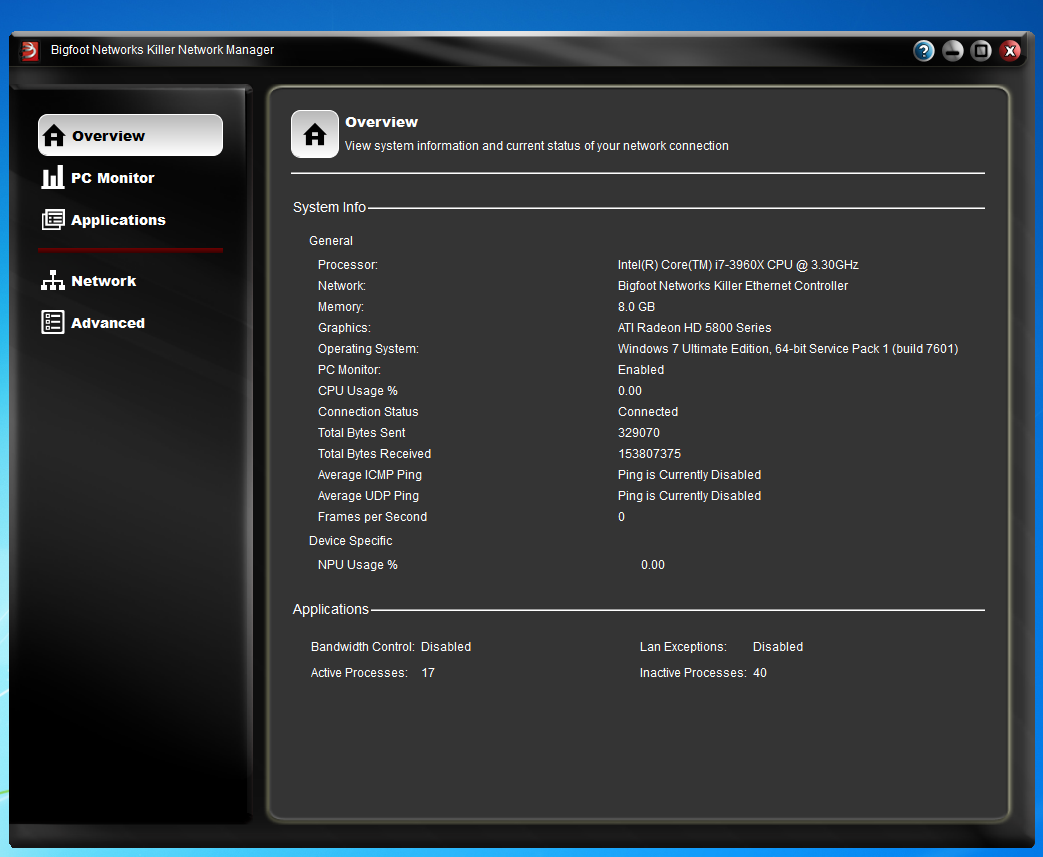 |
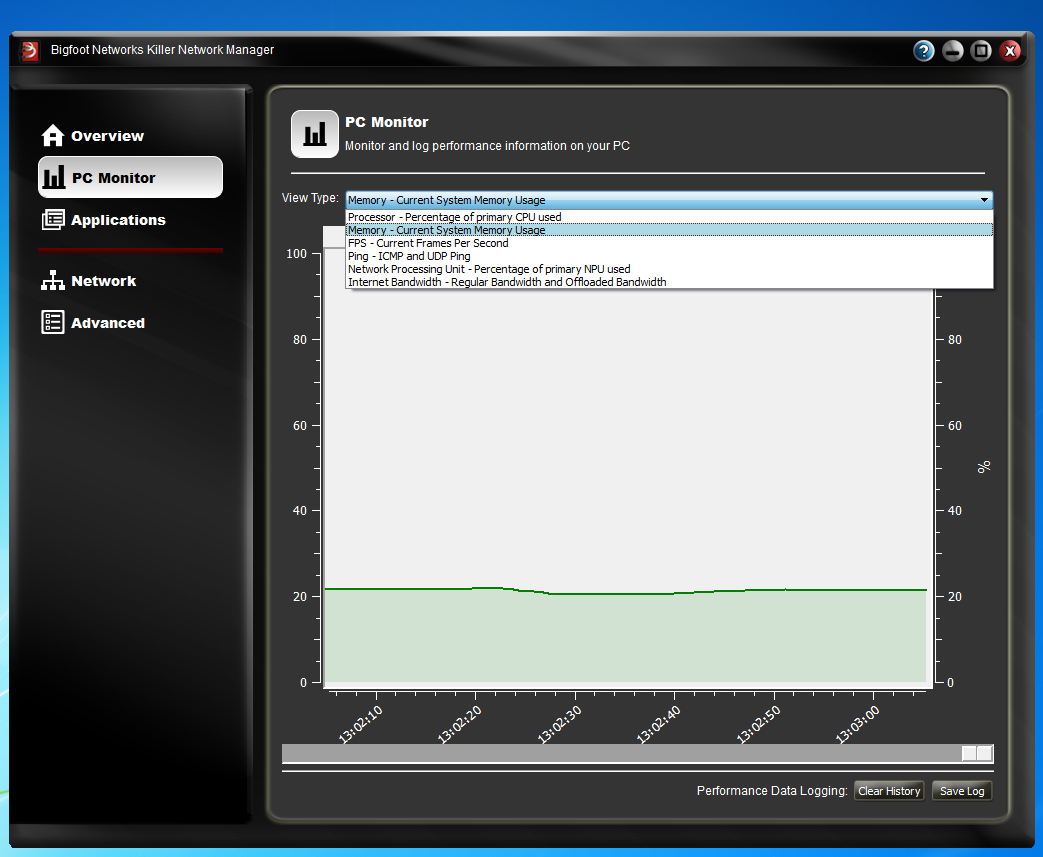 |
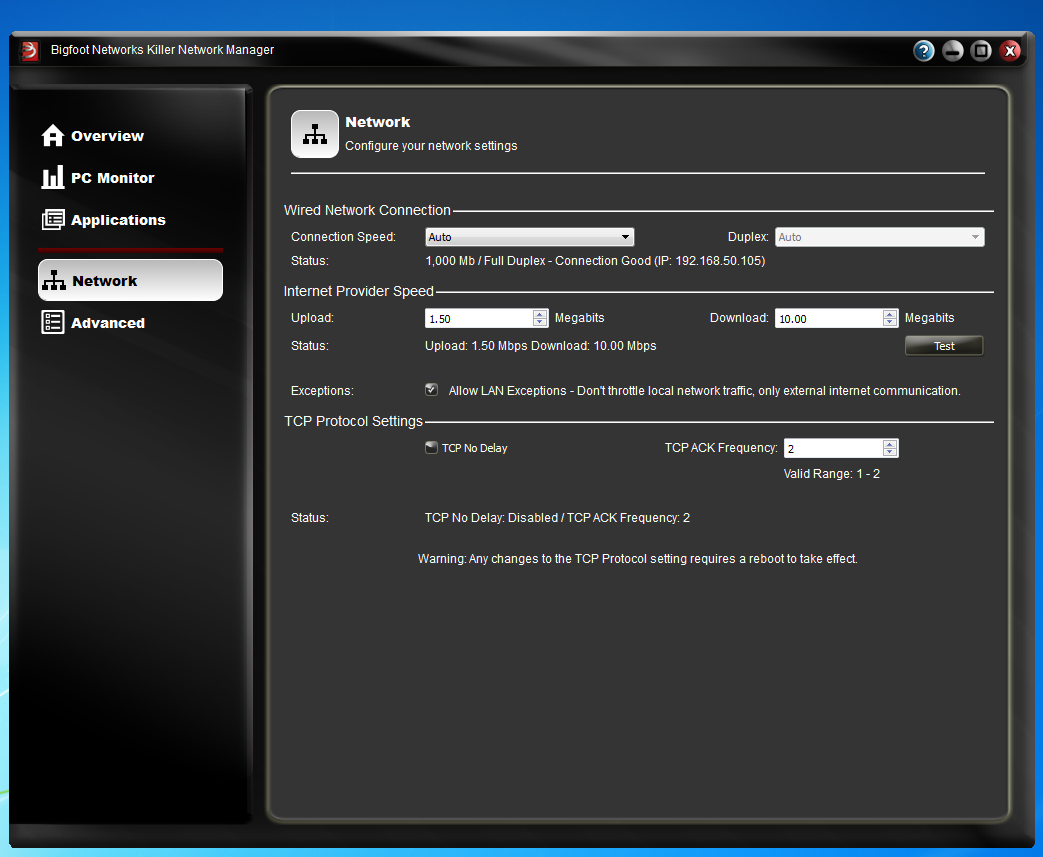 |
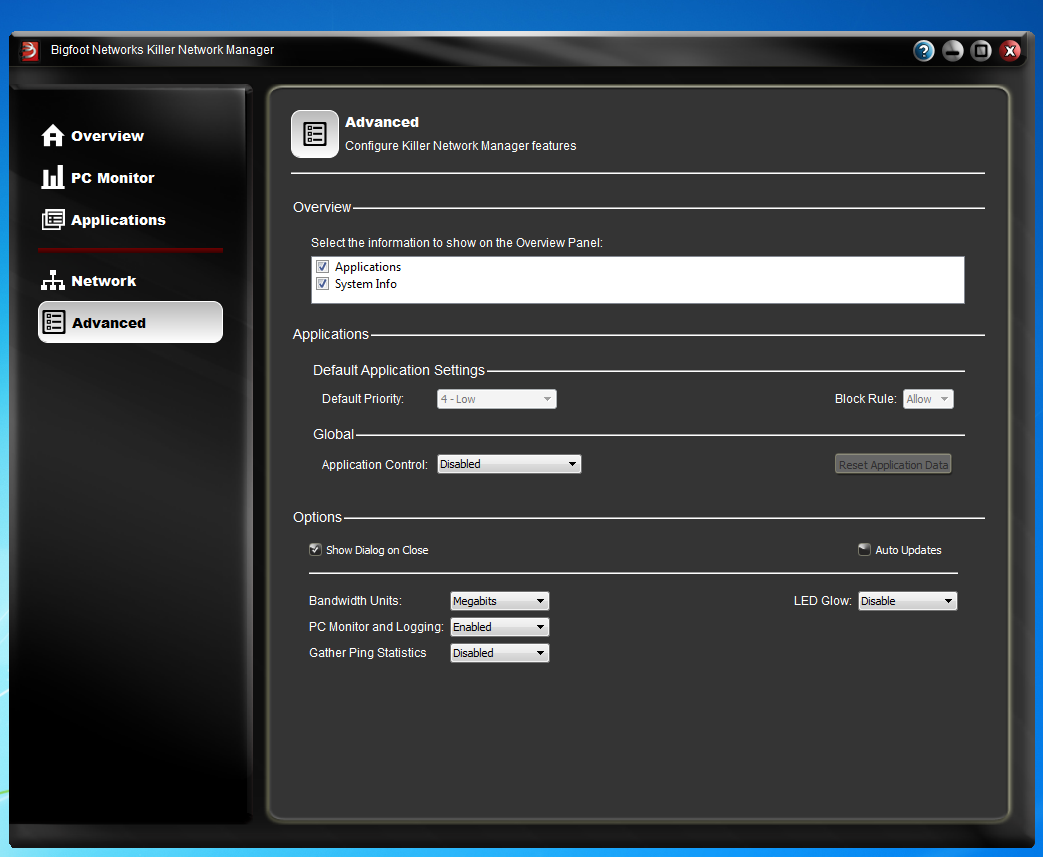 |
The networking is handled by a KillerNIC E2100 network processing unit. This (as we have said before) is not much more than a RISC (reduced instruction set) with a predefined QoS (Quality of Service) profile attached to it through an embedded OS. The drivers/utility that come with it offer you excellent control and monitoring over not only your networking, but also your whole system (for monitoring).
Section II - Performance Tests, Synthetic
In this section of testing we cover the synthetics. These are tests that run a scripted sequence of internal APIs or that use another installed application to perform a series of scripted events. They are great in that they can provide reproducible results across various platforms. On the down side, synthetic tests can be fooled with driver tweaks and optimizations. In some cases it is necessary to rename the .exe file to something generic to discover if this is the case. In any event when this is needed (when a test shows a drastic difference in performance over the renamed exe) we will note this and show both results for comparison.
PCMark7 -
PCMark7 is the latest general performance test from FutureMark. As each generation of this benchmark has evolved and developed we have watched them add more and more realistic tests to this suite. With this generation we find more media tests, (audio and video transcoding) moving of large files, multiple web page rendering, and much more (the even added DX10 gaming). We use the Overall Performance and Common Usage suites in our testing.
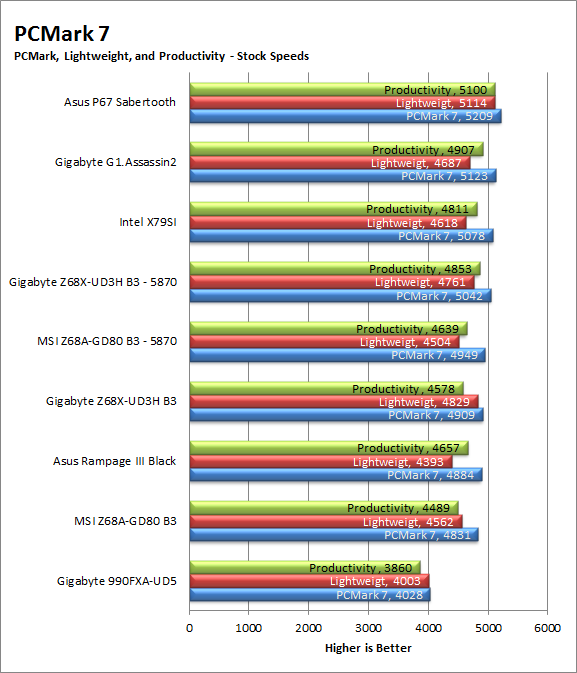
The G1.Assassin2 falls in line just behind the P67 Sabertooth from Asus in our stock PCMark7 run. This is a good indicator that the G1.Assassin2 would be good for most computing tasks. If you were to build this into a single system you would not need to worry if it can handle your spreadsheets or web browsing. 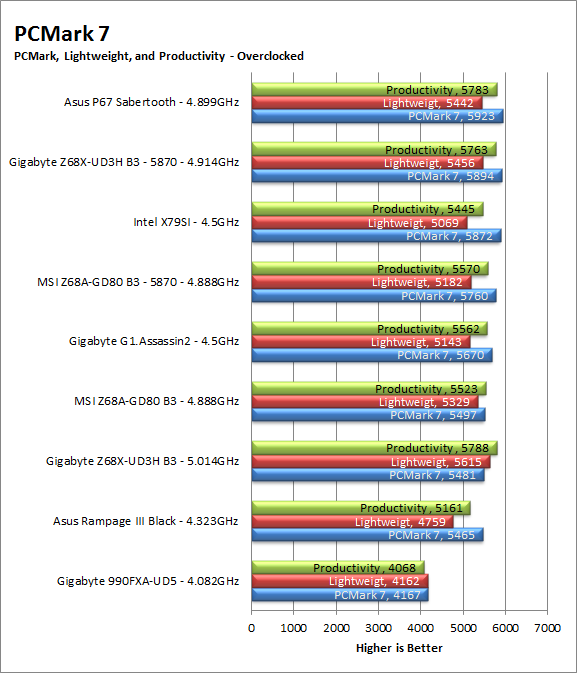
3DMark 11 -
3DMark 11 is the other Futuremark test that we run on our motherboards. This test simulates the typical tasks that a GPU (and system) would have to perform to provide you with a good gaming experience. It is based on the DX9, DX10 and DX11 engines but can only be installed on Windows Vista or later. The suite of tests covers DX9, DX10, and of course DX11 rendering; it also covers AI computations and physics. That’s right I said Physics the latest version of 3DMark uses a Havok physics engine. This removes the advantage that nVidia had with 3DMark Vantage. 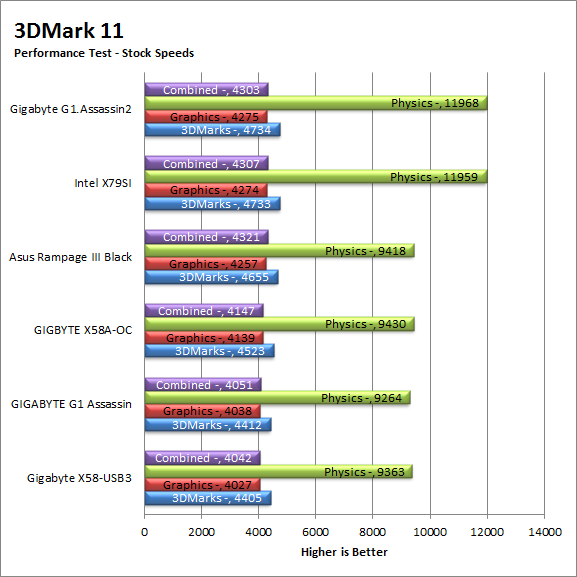
True to its design as a gaming motherboard the G1.Assassin2 gets the top numbers in 3DMark11. The delta between the two top boards is very narrow though. This means that in all honesty you would never know the difference if you had the top two boards playing side by side.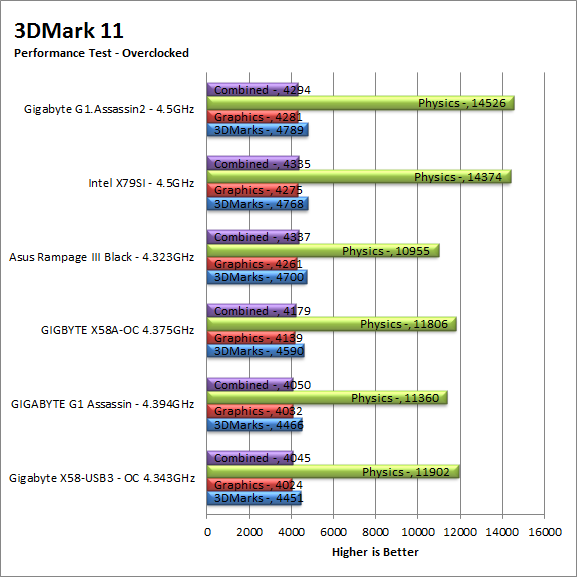
HyperPi 0.99b -
HyperPi is a front end application that allows you to easily run multiple instances of the SuperPi application. SuperPi, for those that are not familiar with it, is an application that measures the time it takes to calculate the number Pi out to as many as 32 million places. This calculation is then checked and run multiple times (up to 24 for a 32M run). This test stresses the CPU, Memory and HDD as data is handed off between the three. If there is a weak link, HyperPi will show it. For our testing we run the 32M test on as many cores (and threads) as the CPU has available. The slowest CPU time is then recorded. 
It looks like the extra memory bandwidth really does payoff. The HyperPi times here are very good considering you are running two full 32M SuperPi run on all cores at the same time. This type of memory to CPU to HDD performance can help with everything from office productivity workloads to transcoding your favorit videos. 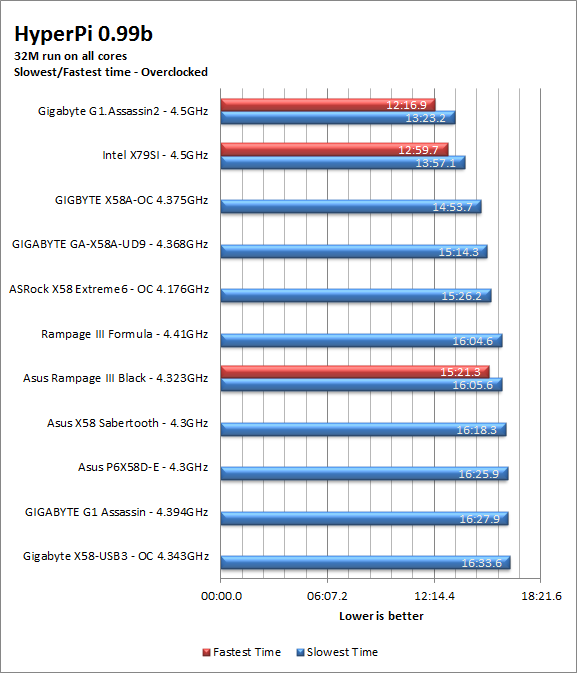
Cinebench R11.5 -
Cinebench R11.5 is the 11th release of Maxon’s rendering test. This test is based off of the Cinema 4D engine, which is one of the industry standard tools for digital animation. It is a powerful product with many different modules that can be “plugged” into it to increase its effectiveness. With Cinebench you get to see how your computer would do using this application. There are two tests; one tests the CPU’s ability to render an image across multiple cores or threads. The other tests your systems ability to handle OpenGL based rendering. 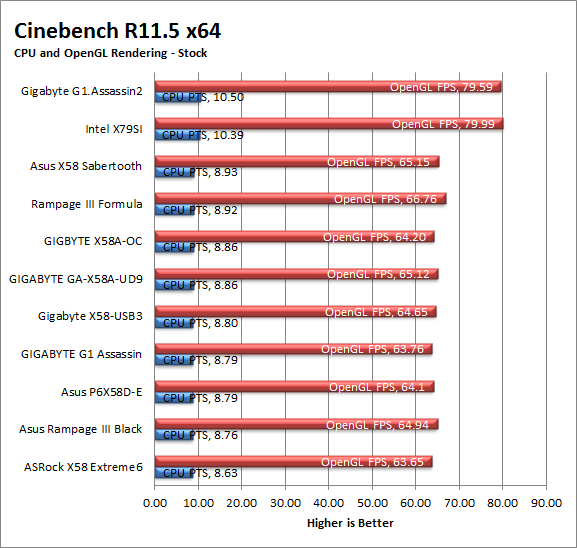
In Cinebench R11.5 the G1.Assassin2 comes out on time again until we overclock it. Despite having the same overclock as the X79SI the Assassin2 comes in right behind (by .01 points) the X79SI. Even this small difference can be huge when you are rendering large scale or multiple frame projects.
Section III - Performance Tests, Real-World
Here we have two tests that are designed to put the performance of the motherboard and its subsystems to the test. Both require good CPU, Memory, HDD and even to a lesser extent audio and network performance. The two tests we chose were Lightwave 3D 9.6 and AutoGK 2.55. We will be adding at least one more real-world test to this battery in the near future, but for now these two cover quite a bit.
Lightwave 3D 9.6 x64 -
Lightwave is another industry standard application for 3D animation and rendering. It has a large tool base and the rendering engine is highly threaded (when using the right render model). This application is also capable of expanding to 4k resolutions as well as ray tracing for rending the light sources. For our testing we use frame 470 of the Pinball scene found in the LW 9 Content folder. This uses the newer perspective camera that is better suited to a multi-CPU/Core environment. This camera style also uses ray tracing and a much improved anti-aliasing method. Settings are shown below in the attached screen shot. Of course these are single frame renders and they are not a complete picture; for that you have to take into account the number of frames an average project would have. In a typical 30 second commercial you will have around 840 to 960 frames (at 28 – 32 FPS) this means that you have to multiply the time of a single frame by that number just to get a vague idea of how long that 30 seconds would take. This is because each frame will have a different render time based on complexity.
We find almost the same story that we saw with Cinebench in our Lightwave testing. The only difference is that the X79SI is slightly faster in each case. The estimated project times show what the 1-2 second difference can do to a full scale project. Looking at what both boards are doing we suspect that this is because of the slower HDD speeds between the two boards. The X79 can simply pull project information from the HDD faster than the G1.Assassin2 can.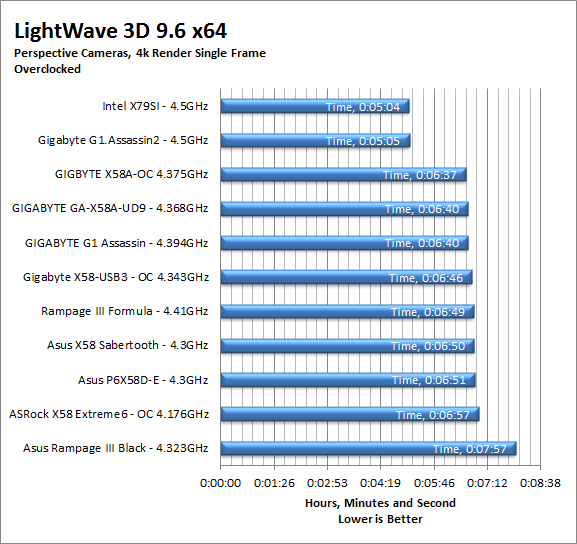
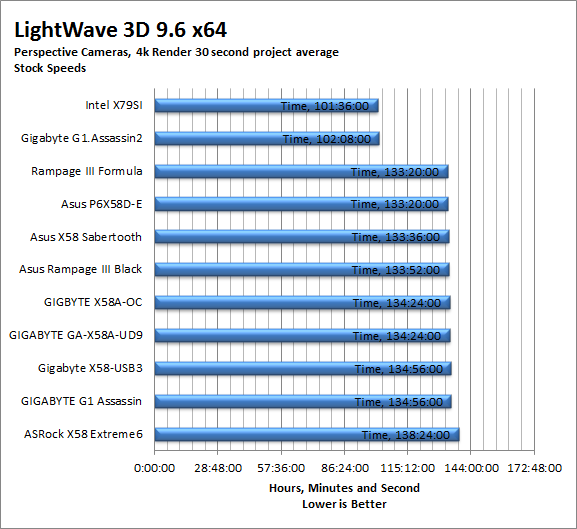
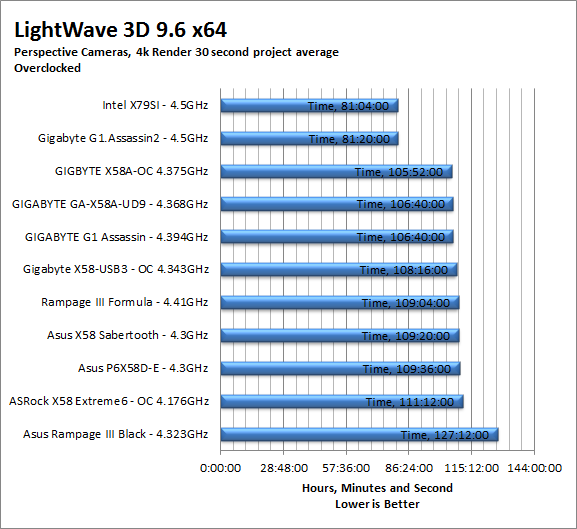
AutoGK 2.55 Transcoding -
AutoGK is a transcoding software that is really multiple parts combined to make an easy to use whole. It combines, items like FDD Show, Xvid encoder, Virtual Dub and others for use in converting one media format to another (usually Xvid AVI). It will not transcode copy protected DVDs or Bluray discs yet (you still need a de-crypter for that). But it does an excellent job on everything else. For our testing we use a 2 hour movie that has been placed onto a standard definition DVD for playback; we then transcode this DVD to a 100% quality AVI with the original audio intact. This puts a strain on the CPU, Memory, HDD and the attached DVD ROM drive.
We are still not able to get AutoGK to work and we are certain that this is an issue with the way the new CPU and Chipset work. We have narrowed down our choice for transcoding app to three main selections we are still checking to make sure there are no vendor specific optimizations in these before we make our choice.
Section IV Performance – Gaming
Gaming as a test of motherboard performance is sort of a joke these days. The big player in the gaming arena is the GPU. Everyone but a few hardcore PR teams know this. However, it is important to run at least a few (one from each current DX version) to see if there are any issues with the combination of components on a motherboard. These are items like Audio lag, memory lag and of course problems with the PCIe lanes and signal traces. If there are issues in design, drivers or BIOS then you can have odd gaming performance. So without much more preamble let’s dive into the three games we currently use; Call of Duty Modern Warfare 2 for DX9 FarCry 2 for DX10 and Battlefield Bad Company 2 for DX11.
Call of Duty Modern Warfare 2 DX9 -
This is an excellent but short game that put you right into the action from the beginning and does not let up the pressure until the very end. The graphics are a little better; most notably the night and thermal imaging have been improved. The AI is still the typical COD “bar fight” style AI, with maybe a tad more finesse. All in all it is not a bad game to play and a decent one to use for testing. Our testing run starts at the bridge and ends after you clear the school in the first level of the game. Settings are shown below as are the performance numbers.
 |
 |
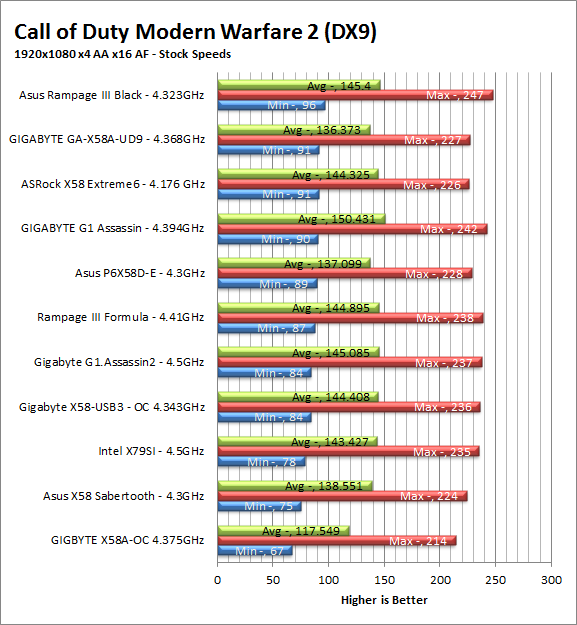
Interestingly enough the G1.Assassin2 is not in the top three of our test group; in fact it is not even in the top five! Instead it falls into 7th place and is 9 FPS (minimum) behind the leader. 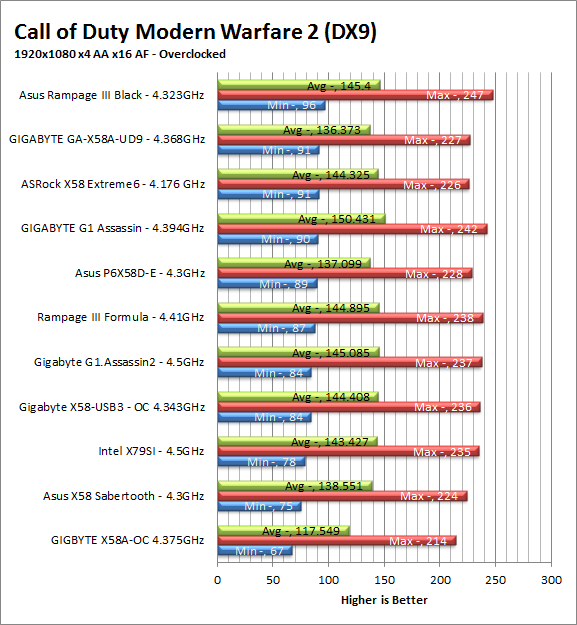
FarCry2 DX10 -
Although not one of my favorite games this tedious game does have some good graphics. The large sandbox style of the game lends to mission based play. The only problem is that the AI is rather low grade. Still the more CPU power the more the bad guys try to do. Over all the game was a little bit of a disappointment to play, but still not a bad DX10 representation. Our testing run starts right after you get your first mission to clean out the safe-house and ends after the hostage rescue. Settings and performance numbers are shown below.
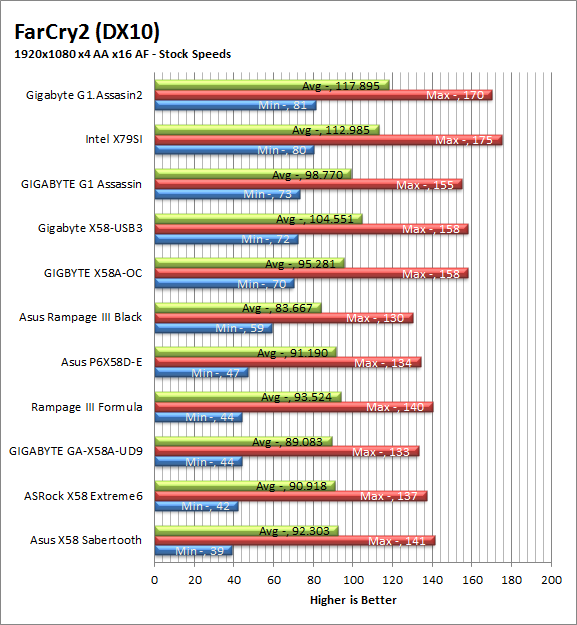
In FarCry 2 the G1.Assassin2 regains some of its speed and ends up out in front for our stock testing. Unfortunately it is only by one FPS which means that this would be a normal variance and certainly is not something that you would see if you were using either of the top two boards. 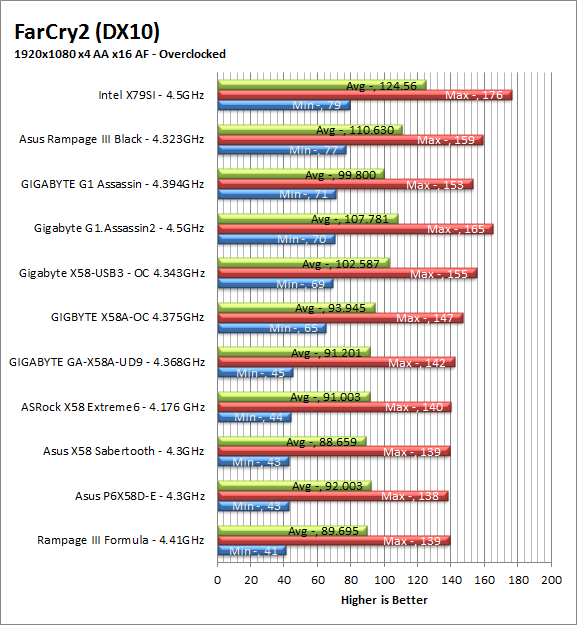
Battlefield Bad Company2 DX11 –
I have liked many of the Battlefield games. They usually tend to be fast paced and fun. With Battlefield Bad Company 2 you do get some of that, but there is something about the graphics and the movement that just does not sit right. The AI is a less sophisticated form of the bar fight AI, but it gets the job done. Still, the game is good for testing as it can put a strain on the components of the board. Out testing run is the entire first level, from beginning to end. Settings are shown below along with the raw numbers.
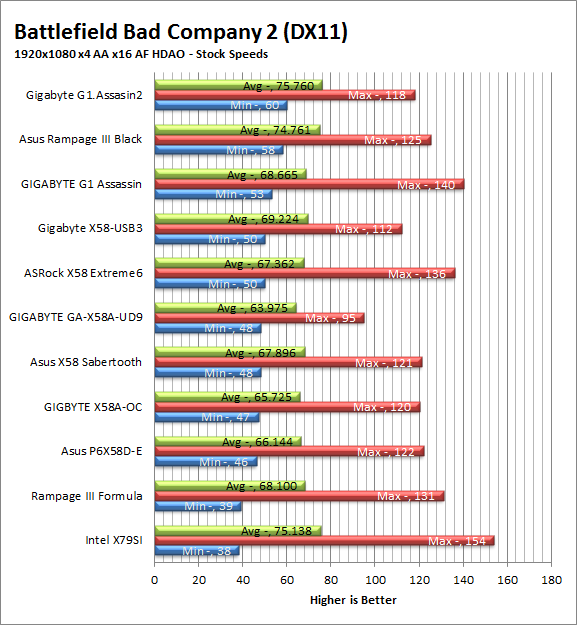
Under Bad Company 2 the G1.Assassin2 comes out on top finally. Once again it is by an exceptionally small margin (2 FPS) which means that while we can call a winner by the numbers, in reality you would never be able to pick which one it was in a line up.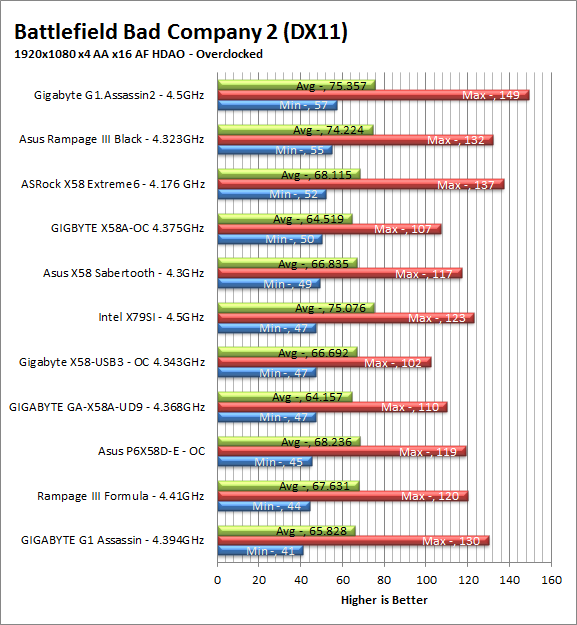
Gaming wrap-up -
The G1.Assassin2 is billed as great for gaming and it is. But it is not going to get you massive leaps in frame per second. Instead where its strength lies is in bringing depth to your gaming experience. The built in Creative Labs X-fi offers solid audio performance in even the most demanding games and in some cases offers an extra level that you cannot get from any other card (with X-Fi HD 5.0). This and the KillerNIC E2100 NPU (for you online gamers) makes the G1.Assassin2 very well suited to keep even the pickiest of gamers happy.
Value -
Value is another very subjective topic. What is expensive to some might be a deal to others. You can look at this topic in multiple ways. One is raw price and the other is what you get for the money. Each is accurate and both are correct ways to look at price/value. We tend to look at features, performance and real-property when we discuss value. However, we also take into account the raw cash cost of the item.
The G1.Assassin2 is a $400 motherboard which is a lot of money to spend. The fact that you can expect to plunk down about $1000 on the CPU you need to get this running makes it appear to be an even more expensive proposition. However, if you look at the average cost of an X79 motherboard and then add in the cost of an X-Fi audio card and a KillerNIC card you will find that the cost is not that far off from the rest of the market.
Conclusion -
The Gigabyte G1.Assassin2 is a solid product. It combines some excellent items that normally a gamer or enthusiast would need to purchase separately into one package and does this without compromising day to day performance or stability. We are not terribly happy that you are limited to only four RAM slots, but in the end that simple design choice will earn you about 500MB/s in memory bandwidth which offsets the lack of expansion room. As a general usage platform the G1.Assassin2 does very well, we had no issues running productivity applications, web browsing, watching DVD movies (these were actually better due to the much better audio) etc. For Workstation performance the G1.Assassin2 seemed to slip a little. It was not as fast as the Intel X79SI, but it is also not being marketed to that crowd. The G1.Assassin2’s strongest showing was in gaming. I am not talking about frames per second, but the whole gaming experience. The built-in X-fi sound card was really able to flesh out the games we use for testing. Gigabyte’s G1.Assassin2 is a worthy successor to the original G1.Assassin; if you are looking to build a gaming rig centered around one of the new Sandy Bridge E CPUs then you will want to pick one of these up.
Discuss this review on our Forum

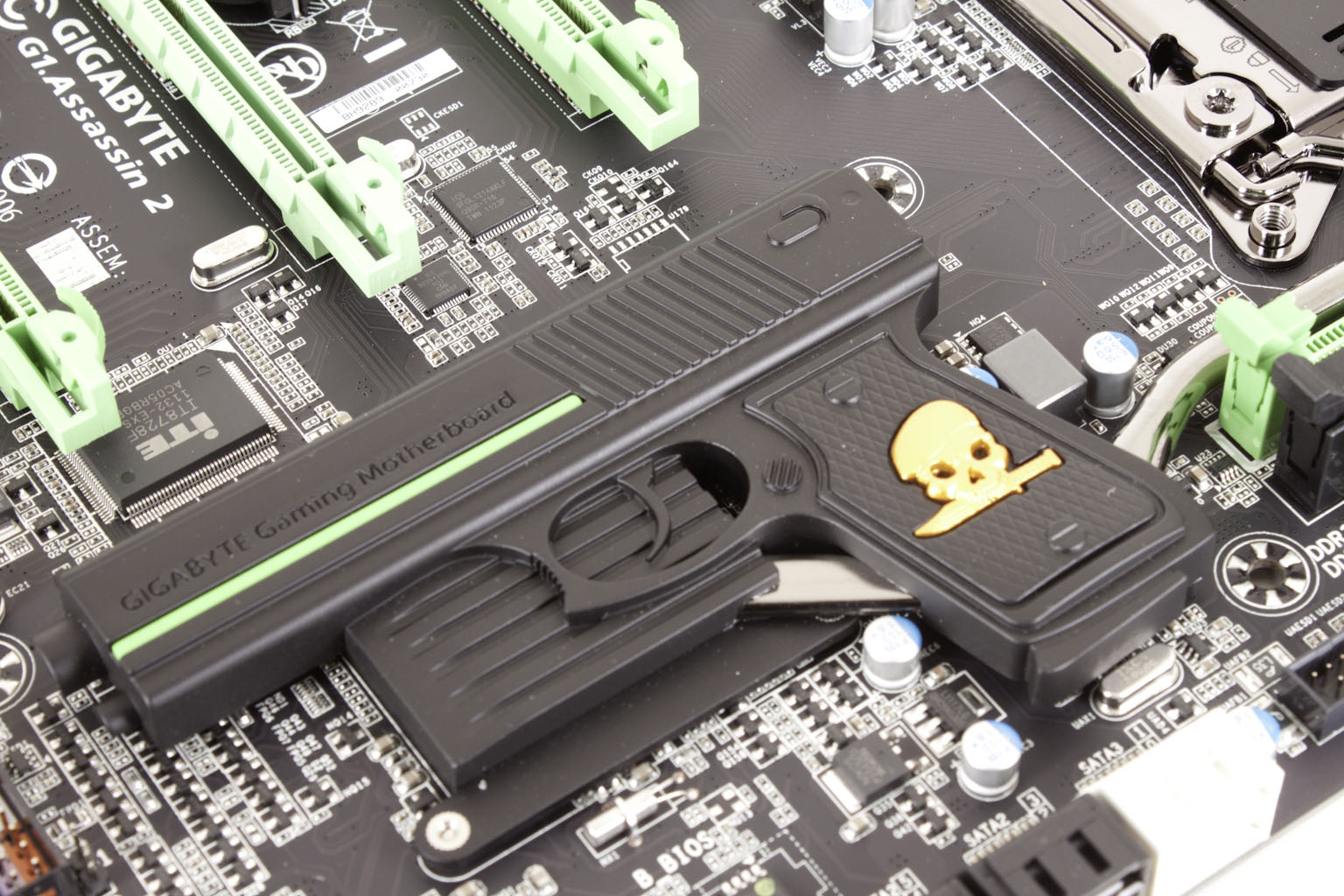 We have now had the G1.Assassin2 up on the test bench for a little over a week now and are ready to talk about our experience with it. The G1.Assassin2 is Gigabyte’s current top of the line x79 motherboard and follows in the same trend as the other boards in the G1 line up. This means that you get the military theme, the built in audio card, and of course the KillerNIC E2100 NPU. However, there are also things that had us concerned about how the G1.Assassin2 might handle certain types of work. So let’s get started and see if all of the new features (like the 3D BIOS and 3D Power) work and if the concerns that we talked about in the
We have now had the G1.Assassin2 up on the test bench for a little over a week now and are ready to talk about our experience with it. The G1.Assassin2 is Gigabyte’s current top of the line x79 motherboard and follows in the same trend as the other boards in the G1 line up. This means that you get the military theme, the built in audio card, and of course the KillerNIC E2100 NPU. However, there are also things that had us concerned about how the G1.Assassin2 might handle certain types of work. So let’s get started and see if all of the new features (like the 3D BIOS and 3D Power) work and if the concerns that we talked about in the 